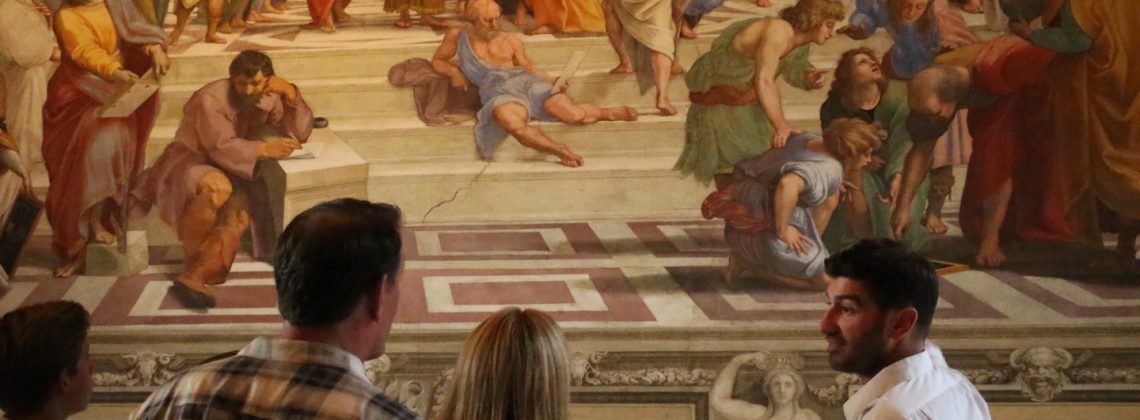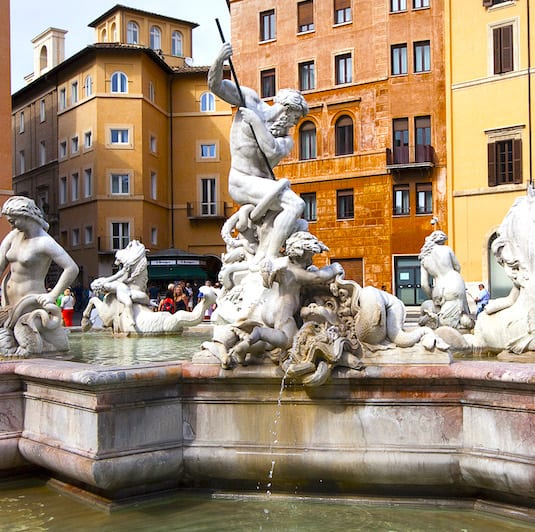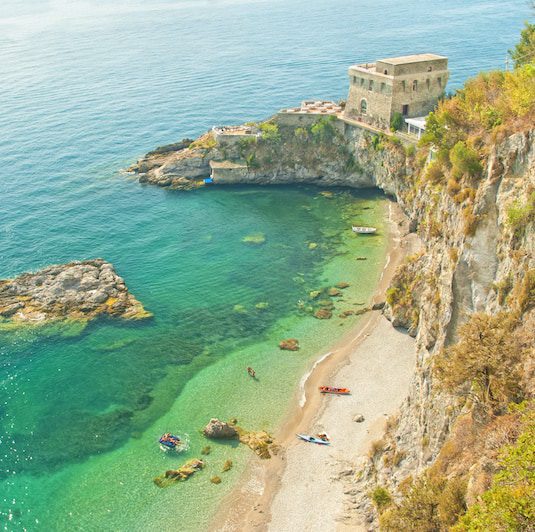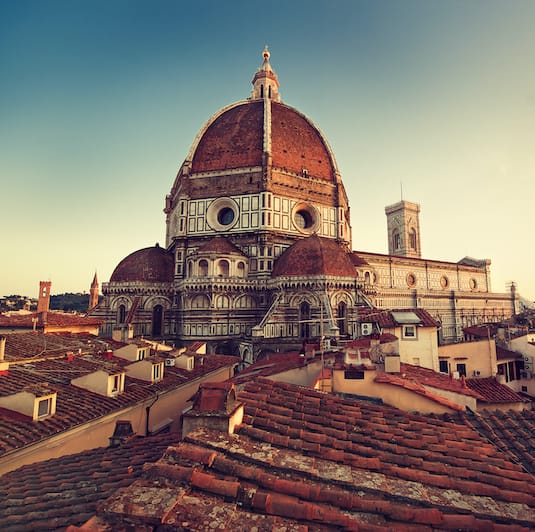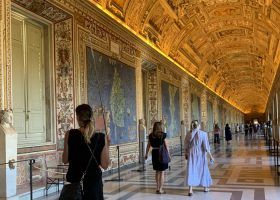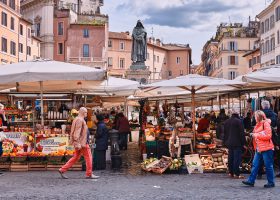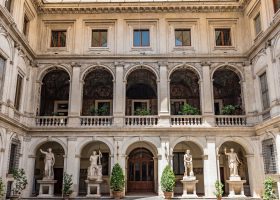Looking for a comprehensive guide to the Vatican Museums? This is likely the most elaborate free guide on the internet detailing the must-see treasures of the Vatican Museums. Written by a licensed Vatican tour guide, Brandon Shaw, this valuable resource contains everything you need to know and more about what to see at the Vatican and why it’s important.
👉 Ready to lock in your visit? Grab your Privileged Entrance Vatican Tour with skip‑the‑line access to the Vatican Museums and the Sistine Chapel.
Ultimate Guide To Must-See Artwork in the Vatican
I hope you’re ready! This is by far our most comprehensive guide to the treasures of the Vatican Museums, covering much of the most important artwork. If you’re looking for something on the lighter side, check out our top 13 things to see at Vatican City. Let’s get started!
1. Spiral Staircase
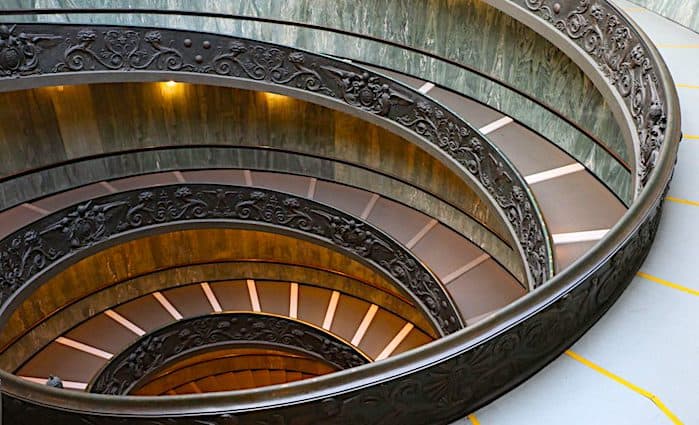
The staircase was built by the famous architect Giuseppe Momo in 1932. It was commissioned by Pope Pius XI and intended to be the new entrance to the Vatican Museums.
At first glance, it’s a bit deceptive because you don’t fully understand the masterpiece in front of you. The staircase is shaped like a double helix—think of the model for DNA.
With two interconnecting spirals—one leading down and one leading up—they were designed for simple crowd control. The Spiral Staricase allows traffic to move freely in each direction.
2. Terrace with a View of the Basilica and Gardens
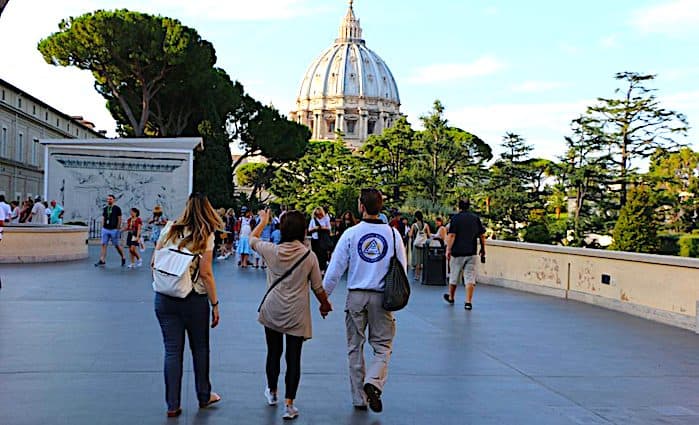
Before you enter the main galleries of the Museums, we highly recommend taking a walk out onto the terrace first. You’ll see this as soon as you leave the escalator to the main floor. Believe it or not, this will be your best photo of the dome of St. Peter’s church. Because of the sheer height of the structure, you need a bit of distance to get a good photo.
Also, look over to your right. You’ll see the beautifully manicured Vatican Gardens. From oak trees to Lebanese cedar trees, the gardens have provided peace and quiet to the various popes who have lived within these walls for centuries. You’ll even see some fountains and small retreats where popes have gone to pray.
3. The Pinacoteca
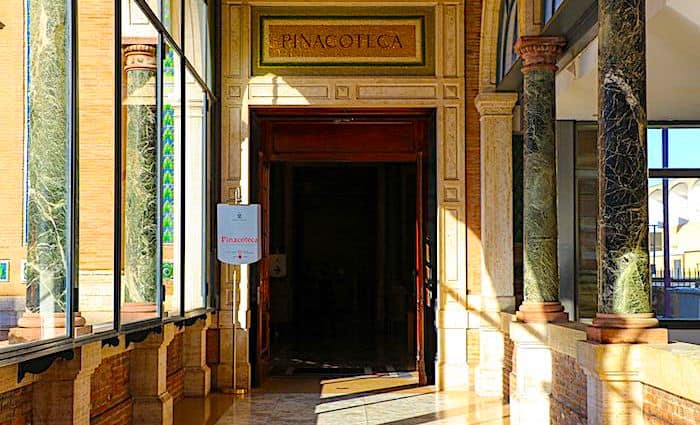
The word pinacoteca means a painting gallery in Italian and the Vatican Pinacoteca Gallery doesn’t disappoint. Since the popes in the Vatican have historically been the main patrons of the arts for centuries, that makes sense.
The idea behind building the Pinacoteca originated in the early 19th century after the defeat of Napoleon. Many of the paintings that had been taken to Paris were brought back to the Vatican. This private collection has continued to grow with various popes and donations. Currently, it houses 460 paintings.
Not ready to book a tour? Check out our Rome Guide for more info.
4. Transfiguration (Raphael)
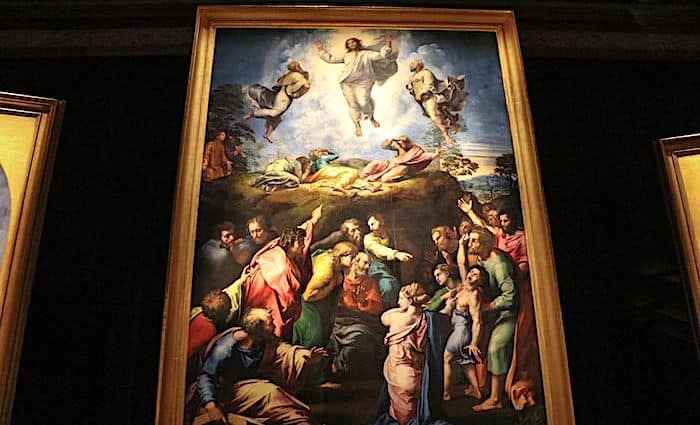
This masterpiece was commissioned by the man who would become Clement VII for a church in France. However, the pope decided to keep it for himself in the end. Ultimately, he donated it to San Pietro in Montorio where it was the altarpiece for two centuries.
Like many pieces, it was taken to France in 1797 by Napoleon and then returned to the Vatican during the treaty of Tolentino after his defeat in 1817. From that moment onwards, it has been a defining piece of High Renaissance painting with its dominant colors and ideal beauty.
Use of Vivid Colors
The painting depicts two stories from the Gospel according to Matthew: the Transfiguration and the meeting of the apostles with the obsessed youth who will be cured when Jesus returns from Mount Tabor. The mastery of the painting is shown in numerous ways, so let’s start with the color. Raphael was famous for his use of vivid colors. Especially now, after the painting has been cleaned, we can see the colors the way Raphael and his contemporaries would have seen them.
Remember that this was made specifically to be an altarpiece, so it would be up above our heads. Our eyes are naturally attracted to brighter colors, and Raphael played on this perfectly by gradually making the colors brighter the further up you look. In doing so, Raphael is guiding you on how to look at this painting by using your own senses. The artist wants you to look at the scene below first and then work your way up to the top of the painting, culminating in Christ himself.
This was Raphael’s last painting. Georgio Vasari, Raphael’s contemporary and biographer, called this painting “the most famous, the most beautiful, and most divine.” It was supposedly laid over his tomb during his funeral. Unfortunately, Raphael died at the young age of 37, supposedly from syphilis. He was buried, and remains to this day, in the Pantheon in Rome.
5. The Annunciation (Raphael)
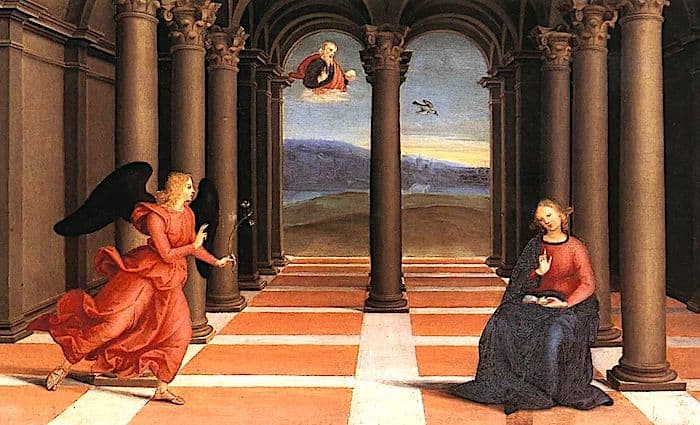
Painted between the years 1502-1504, this is one of Raphael’s earliest works. It was commissioned for the Oddi family for their family chapel in Perugia.
The Angel Gabriel is approaching the Virgin Mary to let her know of the imminent coming of Jesus Christ (Annunciation). Mary is sitting by herself reading a book and seems to be expecting this moment. With ideal beauty reflected in her face and we see this even in the way she holds up her one hand in welcoming the Angel.
In the background you can see two arches that open up to a clear sky. One of Raphael’s trademarks was to add deep perspective in his paintings with a light blue color sky to show the most distant point.
You will also notice the 3D effect he creates with the columns and the dove in the distance. This painting resembles a very similar painting by his teacher Perugino. Raphael would have studied under the Early Renaissance master and, eventually, he achieved such mastery that many said that they couldn’t tell the difference between master and student.
6. The Crowning of the Virgin (Raphael)
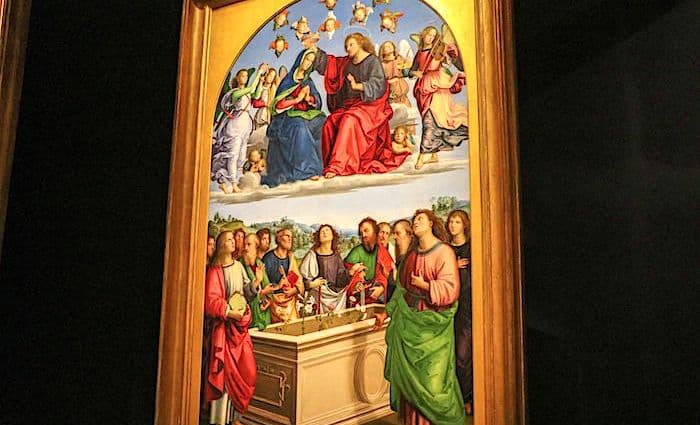
This painting was also part of the altarpiece for the Oddi family chapel in Perugia. I have to say that this is one of my personal favorites due to the simple and elegant beauty that the Master shows in the figures of each individual person depicted.
The painting is broken down into two scenes. The bottom half shows the grave where the Virgin Mary was laid to rest with the apostles around her. St. Thomas is holding the girdle, which was given as a gift from the virgin herself. Where she would have been in the tomb, there are flowers as she has since ascended to heaven. The apostles are all looking in amazement as they see her image above with Jesus.
The upper portion of the painting depicts the Virgin Mary and Jesus, who is crowning her as the blessed mother. There are angels surrounding them and some are even playing musical instruments. The play on color is similar to the Transfiguration, where the darker colors are below and as your eyes naturally ascend upwards, the color scheme becomes lighter. The faces show the ideal beauty of man, which is expressed even more so in the angelic face of the Virgin Mary.
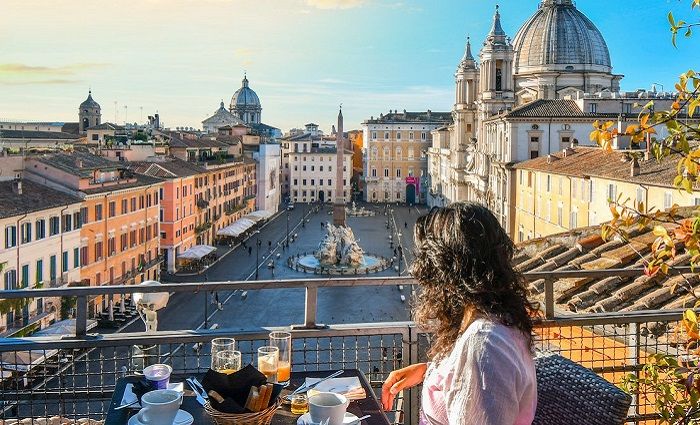
Find Rome’s Best Hotels
Rome has a rich cultural history and many iconic landmarks to explore. Plan where to stay in the magnificent Eternal City in the best neighborhoods.
7. St. Jerome (Da Vinci)
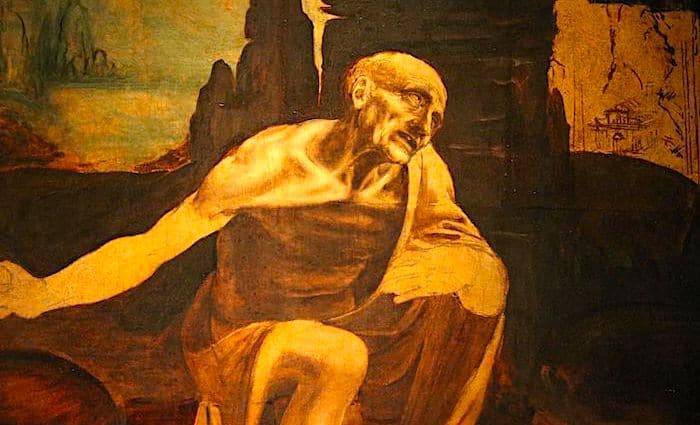
This is one of the most enigmatic paintings by the master, Da Vinci, and the story behind the art piece is even more intriguing. Da Vinci was known for not finishing many of his commissions since his brain seemed to outpace and outthink that of most mere mortals. While this art piece is only a sketch, it reveals the genius of the man.
It depicts St. Jerome who, for his love of God, lived as an ascetic for many years in the Syrian desert. He’s always depicted in an emaciated manner, and this sketch is no different. Old and bald in the picture, he has the look of a man who has endured serious pain in his life. He’s sitting down with the lion at his feet (his companion after having pulled a thorn from the lion’s foot). Also, he holds a rock in his hand, which he would traditionally use to beat himself on the chest as penance.
The first time we hear of this art piece is at the beginning of the 19th century on Angela Kauffman’s death. It was supposedly in her will but disappears from history until it is bought by Napoleon’s uncle, Cardinal Joseph Fesch.
The story is quite fascinating as it appears that it was divided into two pieces. The lower part was found in a second-hand shop where it was used as the cover for a box. The upper part, with St. Jerome’s head, was found at his shoe maker’s, where it was used as a cover for his stool. Upon his death, it was auctioned and exchanged hands a few times. It was finally bought by Pope Pius IX in 1856 where it has been ever since.
8. St Matthew (Guido Reni)
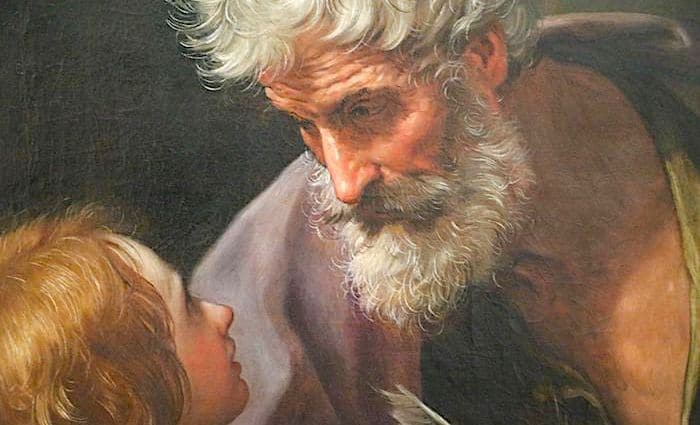
Guido Reni was part of the group of artists from Bologna who would burst onto the Italian painting scene in the 17th century and redefine the term “baroque”. Together with the Carracci cousins and Domenichino, they started the academy called Incamminati. This was a rebellion over the Manneristic paintings of the time. Creating a more classical movement, they redefined an entire generation of painting.
This piece shows the Apostle Matthew as he takes a break from his writing to look at an angel. Gone are the days of ideal beauty and deep perspective from the High Renaissance as we look at this masterpiece. The apostle has been depicted as an old man we would recognize today, with wrinkles on his forehead, disheveled hair, and straining veins in the neck. The angel has rosy cheeks and an almost anemic look that you could find in many boys today.
The magic of this painting is the action taking place. Neither of them is speaking. The angel looks up at St. Matthew in a loving manner who returns the look of affection with his own loving gaze. If this scene was taken out of context, you would easily think it was a painting of a grandfather and grandson, expressing their love for each other. It’s as if they don’t need to speak to understand each other perfectly.
9. Deposition (Caravaggio)
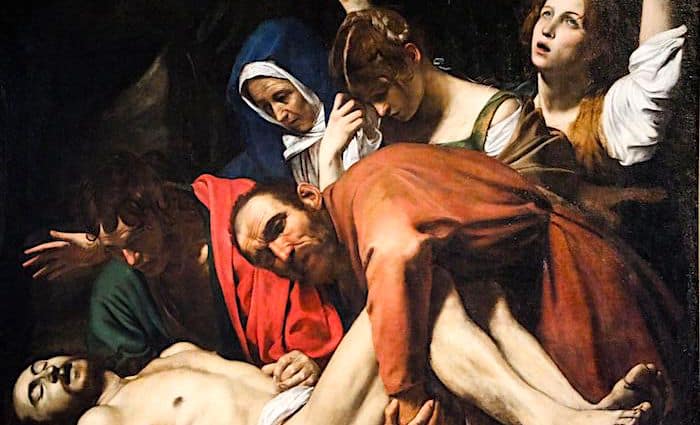
It would be difficult not to write an entire book about this painting or about Caravaggio’s artwork in general. His impact on painters and paintings in the 17th century is mind-boggling with his realist trend. Up to this point, there were set templates of how to paint saints and holy people. Caravaggio smashed these concepts, forever changing the art world.
Here, in one of Caravaggio’s greatest masterpieces, we see Jesus not being laid in the tomb but on the anointing stone by Nicodemus and John. Close to him are the Virgin Mary, Mary Magdalene, and Mary of Cleophas who is raising her arms and eyes towards heaven in prayer.
It’s an extremely pious moment with everyone’s expressions of sadness. There is no perspective, only blackness. You can see the muscles bulging from Nicodemus’ legs. There’s nothing ideal expressed here except the extreme agony that everyone present is experiencing.
Caravaggio’s life was anything but usual. Known to walk around Rome with a sword, he was supposedly part of a local gang and even killed a man in a duel. As a result, he was forced to flee Rome and made many travels south painting along the way from Naples to Sicily, to Malta, and back. As the legend goes, he was waiting for a pardon from Pope Urban VIII when one of his enemies finally caught up with him and killed him in Porto Ercole.
10. Crucifixion of Saint Peter (Guido Reni)
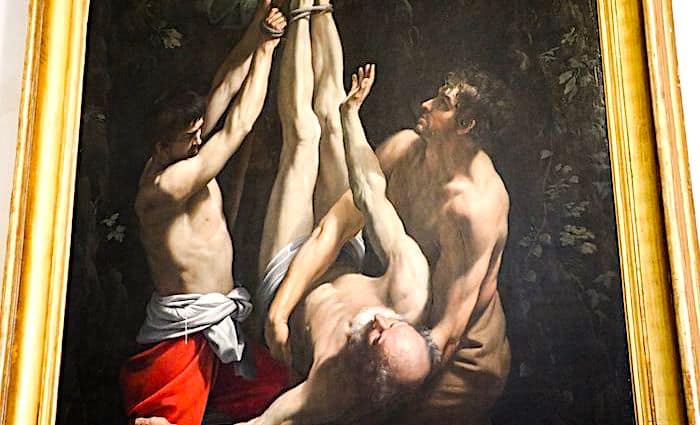
Caravaggio’s influence on Guido Reni in this painting is undeniable. This painting marks Guido Reni’s first success in Rome, having painted this in 1605. It was commissioned by Cardinal Pietro Aldobrandini for the S. Paolo alle Tre Fontane. It was later sent to Paris, like so much other artwork, and brought back to Rome in 1819 by Pius VII where it has remained in the Pinacoteca ever since.
Guido Reni would have seen many of Caravaggio’s works in other churches in Rome, not least a painting of the same subject by Caravaggio in the church Santa Maria del Popolo. The painting shows St. Peter being crucified for being a Christian during the reign of Nero in A.D. 68. St. Peter, not feeling worthy to die the same way as Jesus, requests to be crucified upside down and that is what you see happening here.
The first thing you notice is the real-life muscle tone of St. Peter. You can see that there is nothing idealized here and this could have been a real representation of what his body looked like. Next, you notice that there is no perspective, so nothing is happening in the background—there is only blackness. This allows you to focus 100% of your attention on the scene taking place. Finally, you notice the faces of the two men who are crucifying him. There’s basically no expression on their faces—neither sorrow nor malice, it just is.
11. Martyrdom of St. Erasmus (Nicolas Poussin)
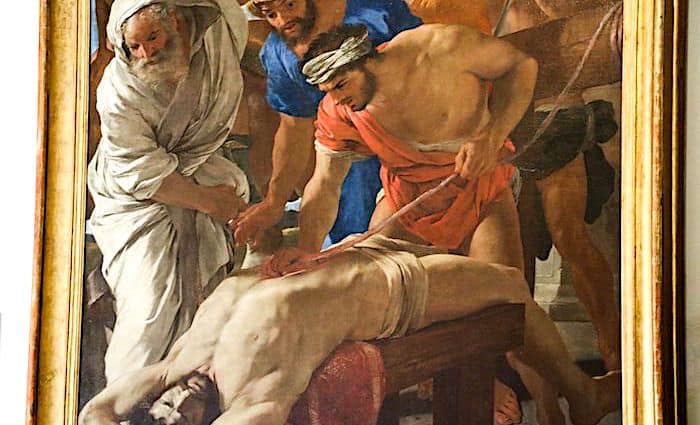
This dramatic painting is Nicolas Poussin’s first in Rome and was painted for the altar in the right transept of St. Peter’s Basilica. This subject was chosen for the relics of the saint preserved there. This painting was also taken to Paris and finally returned to Rome in 1820 by Pius VII and placed in the Pinacoteca where it remains to this day.
The painting depicts the martyrdom of St. Erasmus during the persecution of Emperor Diocletian in A.D. 303. The future saint is stretched out with his hands behind his back, while the executioner is pulling his intestines from his body and rolling them around a sailor’s capstan. Above him is a pagan priest who is pointing at a statue of Hercules that Erasmus refused to pray to. Above him are angels who are coming down to him and offering him the palm and crown, which are both symbols of martyrdom.
Besides the graphic nature of the painting, Poussin used extremely vivid colors in this painting, especially white, blue and red. At this point, we are at the height of the baroque and also the realist movement started by Caravaggio. Most people don’t know that this painting was actually given to the painter Pietro da Cortona, but was then handed over to Poussin who even used the preparatory sketches made by da Cortona for the painting.
12. Astronomical Observations (Donato Creti)
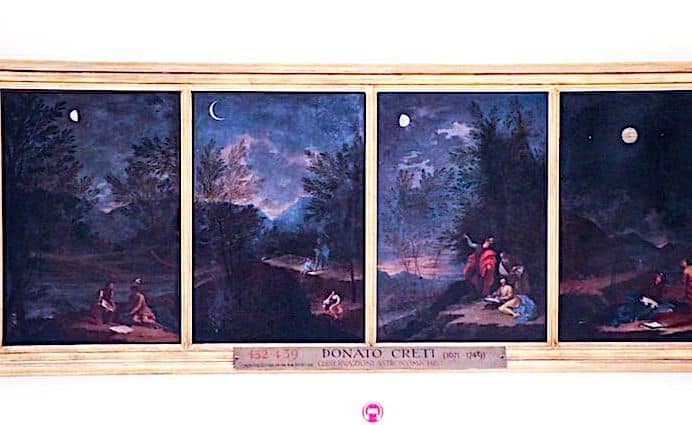
The Bolognese count Luigi Marsili had this series of paintings commissioned in order to create a collection and give them as a gift the pope Clement XI. The idea was to create a strong case for the church to understand the importance of an astronomical observatory. His plan worked since it was blessed by Pope Clement and an observatory was opened soon after in Bologna.
The collection is actually made up of eight canvases, which show the astronomical bodies known at the time: the Sun, Moon, Earth, Mars, Venus, Jupiter, Saturn, and a comet. The only one missing is Uranus, which wouldn’t be discovered until 1781. In the painting, you will notice various telescopes and optical instruments that were being used at the time to observe the celestial bodies. In the background, you will also see many figures of people observing the gigantic bodies in 18th-century clothing.
Looking at this painting allows you to time travel back to the early 18th century and see what it would have been like to be an astronomer in those days. Imagine the excitement of looking into the night sky and seeing all of these heavenly bodies 250 years before TV was invented. The power of their instruments is also on display since we know that they could already see the rings around Saturn.
13. Adam and Eve in the Garden of Eden (Wenzel Peter)
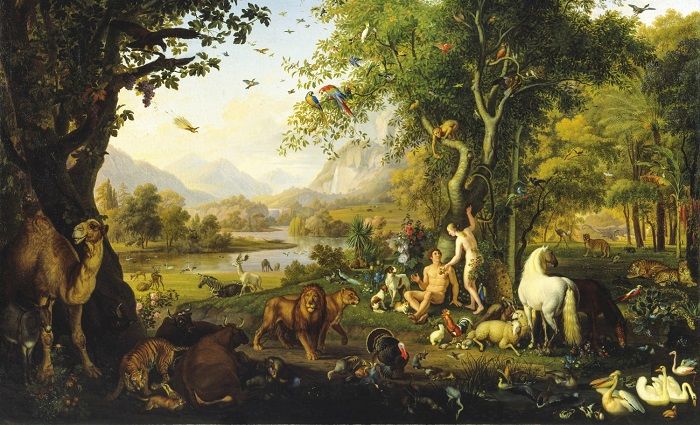
While the painting at first strikes you as a bit odd to have in the Vatican Collection, upon further examination you will see that this is one of the most devout paintings in the collection. Wenzel Peter was an animalist painter, which means that he specialized in painting animals of all sorts. Due to his dedication to one particular type of painting, he was able to portray these animals in an extremely realistic fashion either sitting or standing and the figures look almost as if they have been photographed.
The masterpiece portrays the Garden of Eden with Adam and Eve. They are both pleasantly portrayed here as two young people living in paradise. There is nothing vulgar or too “realistic” about them and both of them are covered naturally so as not to show any indecency. There are over 200 animals from all over the world shown in this painting, and each one has been portrayed with precision. Since this is the Garden of Eden, you will notice that the animals, regardless of type, are all living in harmony together with humans, which is how it would have been in the beginning, according to Genesis.
Gregory XVI (pontiff from 1831 to 1846) liked his paintings so much that, in 1831, he purchased 20 pieces to put in the Room of the Consistory in the Papal State Apartment. What you’ll notice is that in the 18th century, artists started to reintroduce perspective by portraying long distances again. This came after the 17th century when perspective was lost to a black background and figures showing a “realist” approach, which could even be crude.
14. The Pinecone Courtyard
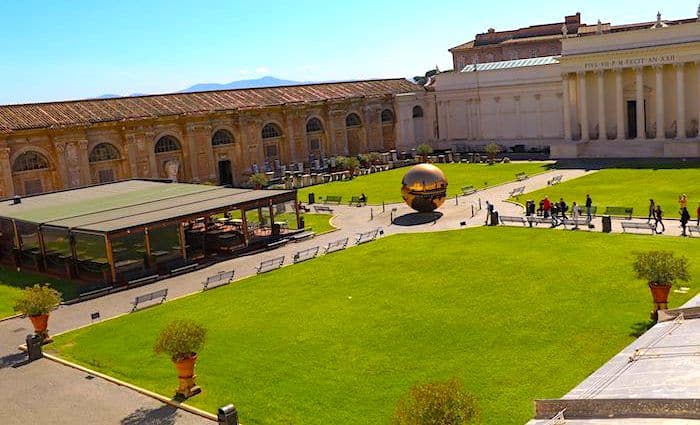
The Pinecone Courtyard is a massive courtyard that connects the main galleries leading to the Sistine Chapel with the Pio Clementino and Braccio Nuovo Galleries.
Reports have been written of jousting tournaments and bullfights taking place here under the Borgia Pope Alexander VI in the 15th century and, supposedly, Pope Leo X housed his pet elephant, Hanno, here in the 16th century.
Not ready to book a tour? Check out our Rome Guide for more info.
15. The Colossal Statue of Augustus
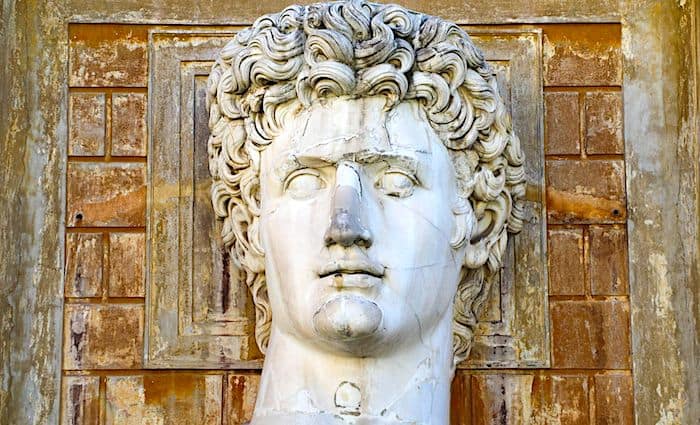
The first and one of the most important Roman Emperors has become immortal in this courtyard, with a huge statue of his head on display in the middle of the courtyard. Here he is shown quite young, but he actually lived to the old age of 75 and was also emperor during the early years of Jesus.
16. Sphere within a Sphere
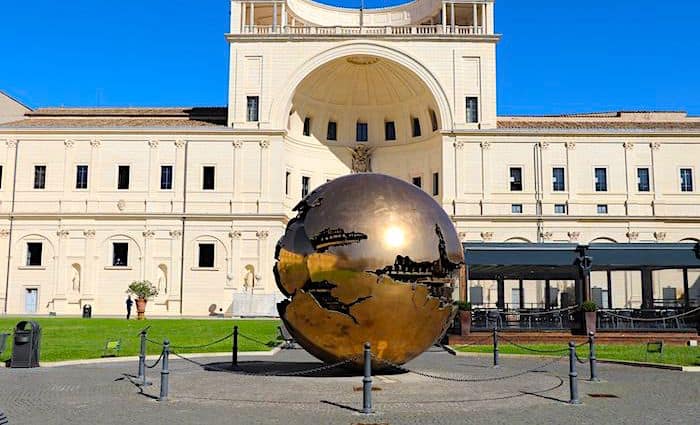
The Vatican also believes in modern art, which is why, when you enter the courtyard, you’ll find this piece right smack in the middle. The statue was created by the artist Arnoldo Pomodoro whose name translates as Arnold the tomato. The artwork is called Sphere Within a Sphere and reflects our outer selves, or the world we show to others, and our inner self.
17. The Pinecone
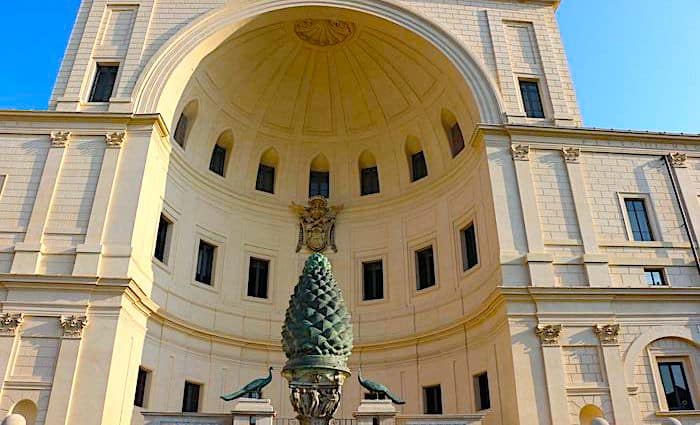
The courtyard itself is named for this massive bronze pinecone that you encounter as soon as you walk outside. Dating back to the second century A.D., this statue appears to have originally been built as part of a fountain complex. If you get up close, you can see the many holes where water would have squirted out.
At some point after, the statue was placed in the courtyard of the first St.Peter’s Basilica, built by Emperor Constantine, before you entered the church. Later, it was moved over to this courtyard.
18. Pio-Clementino Gallery
The collection of the classical statues you will see in these galleries was started back at the beginning of the 16th century by Pope Julius II. The Pio-Clementino Gallery, however, was named for the later popes Clement XIV(1769-1774) and Pius VI (1775-1799) who created the current galleries you will walk through. Much of the artwork here was taken by Napoleon, but brought back to the museum after his defeat.
19. Apoxyomenos
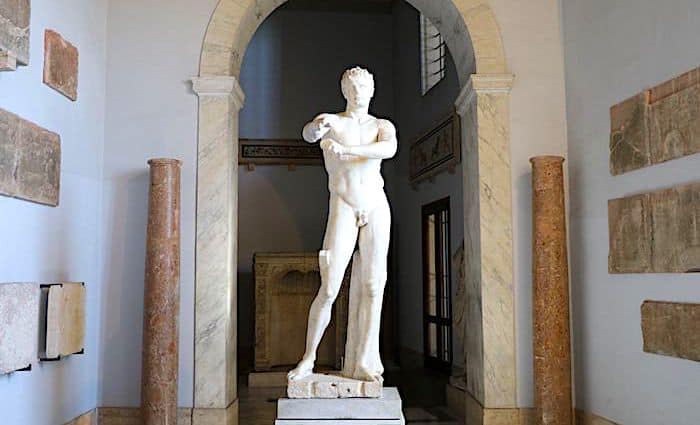
The name of the statue literally means “to clean oneself” and that is exactly what this athlete is doing. Back in the day, athletes would clean themselves by rubbing oil into their skin, applying dust, and would scrape it off with a curved instrument called a strigil.
The statue is a Roman copy from around A.D. 50 of an original Greek bronze sculpture by the great Lysippus from around 320 B.C. Of particular note is the motion of his foot in the air and also the extension of the arm.
20. Apollo Belvedere
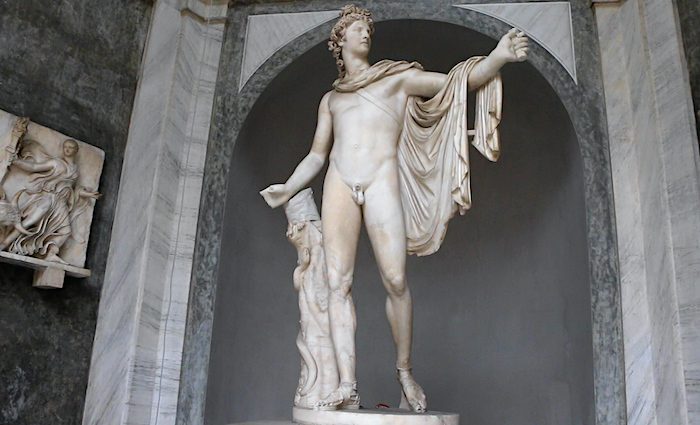
This statue has been in the Vatican since 1508. It was owned by Pope Julius II before he was even pope. The sun god Apollo has just let go of an arrow and is watching where it will land. The statue is a Roman copy from the mid-2nd century A.D. of an original Greek bronze statue by Leochares from around 320 B.C. The exquisite hairstyle and flowing cape are remarkable for its time.
Johann Joachim Winckelmann called it, “of all the works of antiquity that have escaped destruction, the statue of Apollo represents the highest ideal of art.” Another interesting fact about this statue is if you look closely at the face, you will see a resemblance of Jesus Christ in the Last Judgement by Michelangelo. He would have studied these statues and used them as inspiration for his own works.
21. Laocoön Group
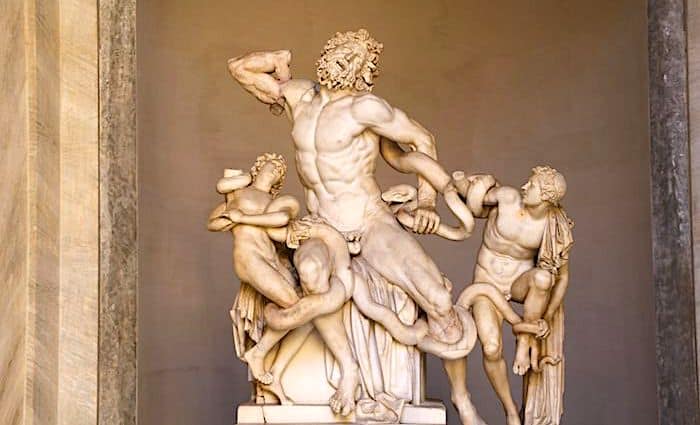
The statue was discovered on the Esquiline Hill in 1506 and was immediately brought to the Vatican for Pope Julius II. It is believed to be an original Greek statue made around 40 B.C. Once uncovered, it was identified right away as the Laocoön statues made by the sculptors on the island of Rhodes.
As the story goes, when they found it, it was missing its right arm. Many artists made their own rendition of the arm with it pointing straight up in the air. Michelangelo, looking at the body movement, realized that the arm should be bent. They finally discovered the original arm in the 17th century, and guess what it looked like? Yup, the arm was bent just as Michelangelo had proposed. Supposedly, Michelangelo’s arm is still connected to the back of the statue today.
This work of art represents a story from the Aeneid by Virgil where all the Trojans were excited to receive the Trojan horse inside the city—everyone except the priest Laocoön, who warned it would be their downfall. Athena, who was siding with the Greeks, sent two serpents to kill the priest and his two sons, silencing them forever. The rest is history.
22. The Belvedere Torso
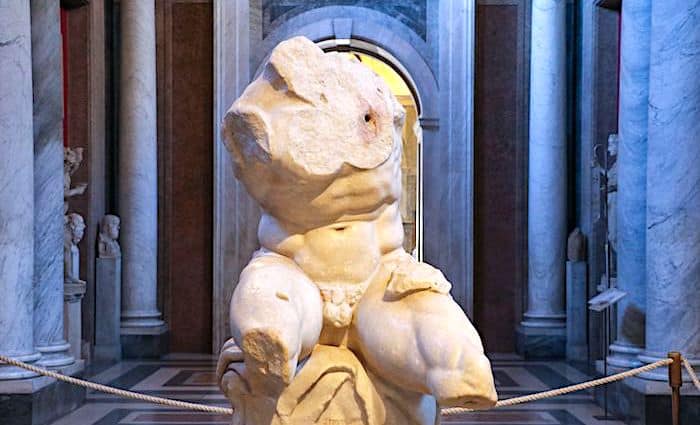
This statue was found in the late 15th century and was in the Vatican collection by 1530. While the exact figure is unknown, many believe it to be Ajax contemplating his suicide after losing the competition with Odysseus from the Iliad. It is signed by an Athenian sculptor named Apollonios and would be a marble copy of an original bronze made sometime in the mid-2nd century B.C.
Many are surprised when they walk into this room and find just a torso by itself. That’s because we are modern people who take certain things for granted. The magic of this statue is that the body is in motion, contorting to his left while all of his muscles compliment that movement perfectly, which means the sculptor had intimate knowledge of anatomy. This was a big deal even in the Renaissance period, since it was forbidden to dissect humans to study muscles and anatomy.
When Michelangelo saw this statue, he supposedly said that it was the most perfect statue, anatomically speaking, that he had ever seen. His admiration for this work will be shown over and over again in the Sistine Chapel. When looking at the Sistine Chapel, you will notice all the angels around each ceiling painting are curving their bodies in the same direction as this torso.
In his Last Judgement, you’ll see St. Bartholomew whose body is also contorting to a degree in this fashion. In his twilight years, practically blind, he was said to visit the statue regularly and just run his hands over the muscles.
23. The Bath of Nero
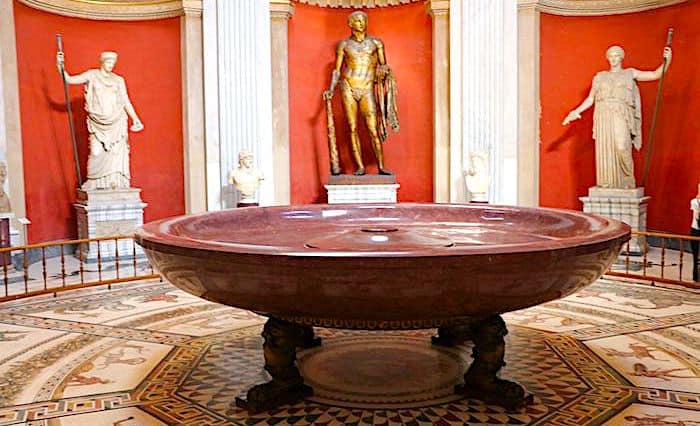
This impressive piece of stone is made from a purple marble called Red Porphyry. The stone originates from Egypt and was the most highly-prized stone, reserved for the emperors. The color purple was the most prized due to its scarcity. In order to collect one gram of purple dye, they would have to extract it from 10,000 sea snails. That’s why when the Romans found this stone, they collected every available bit of it.
The so-called Bath of Nero was more likely to be a fountain than an actual bath. It was found at Nero’s house, the Domus Aurea, over on the Esquiline hill and brought over to the Vatican. Stories had been circulated of Nero’s tyranny and eccentric behavior and so, over time, the rumor started about this being his actual bathtub. We will never truly know what it was used for, but we can say for sure it is a beautiful piece of marble.
24. Statue of Hercules in Bronze
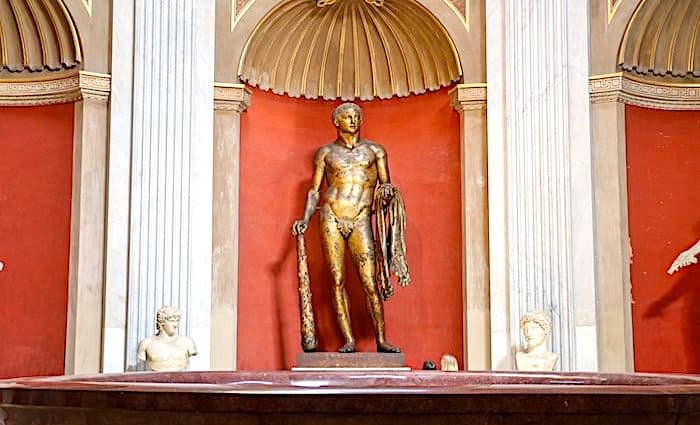
To find an ancient statue in bronze is truly a gift, considering that most were melted down by the Romans back in the day to recycle the metal. This particular statue of Hercules is gilded with big eyes staring at you and curly hair. It was found in 1864 under a courtyard near Campo de’ Fiori and near where the Theater of Pompey was (where Julius Caesar was assassinated).
Soon after, it was given to Pope Pius IX (1846-1878). Hercules is easily identifiable due to the Nemean lion skin draped over his arm, the club he’s resting on, and the apples of the Hesperides in his left hand. The statue has been dated with a few different dates ranging from the first to the third centuries A.D. Historians point to the style being copied from the Neo-Attic style of the fourth century B.C.
What most people don’t know about this statue is that when they found it, it was lying on its back with a slab of travertine stone on top of it like a burial. On top of the slab of stone the letters F C S (Fulgur Conditum Summanium) were cut. The statue had been struck by lightning, and since Hercules was the son of Zeus, the ancient Romans had taken that as a sign that the statue should be properly buried together with the remains of a lamb.
25. Sarcophagus of Saint Helena
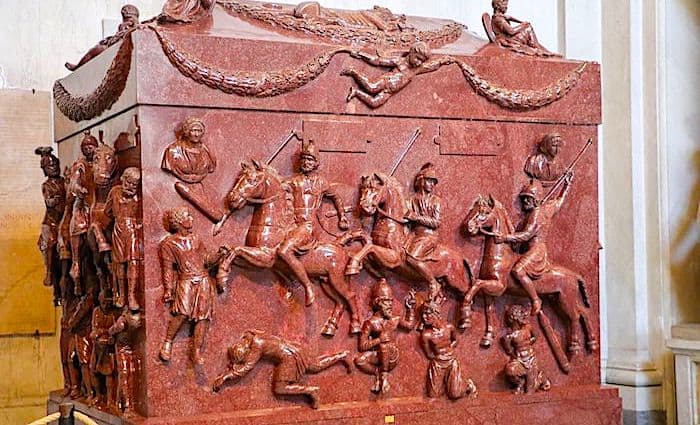
Helena was the mother of Emperor Constantine the Great and died in A.D. 335. She was buried in a mausoleum dedicated to her in Tor Pignattara, which is on the via Casalina outside the city of Rome. In 1777, the sarcophagus was brought to Rome and restored by Gaspare Sibilla and Giovanni Pierantoni. It was at this time that it was mounted on top of four lions carved by Francesco Antonio Franzoni.
Helena was a devout Christian, even before Constantine had won the battle at the Milvian bridge or legalized the religion itself. It is said that she had serious influence over Constantine and his religious beliefs. She led a pilgrimage to the Holy Land where she established the tomb of Jesus Christ and thereafter, under the orders of Constantine, the church of the Holy Sepulcher was built.
The sarcophagus is made of Red Porphyry, which was the color reserved for emperors. The coffin is decorated with military figures and barbarian slaves. The military-themed decoration would have been quite strange for a woman’s tomb, which has led scholars to believe that the resting place was originally created for a man, possibly Constantine’s father or Constantine himself.
Popular Vatican Tours
Best Selling Tour
Privileged Entrance Vatican Tour with Sistine Chapel
Without the right access, visiting the Vatican means fighting crowds, long waits, and missing the most significant rooms and works of art. Our privileged entrance tour offers more than just entry—it’s an immersive experience led by a storytelling guide who brings the Vatican to life. Skip the line and explore the Vatican Museums, including the Raphael Rooms and the Sistine Chapel, with engaging insights that make each moment memorable and meaningful.
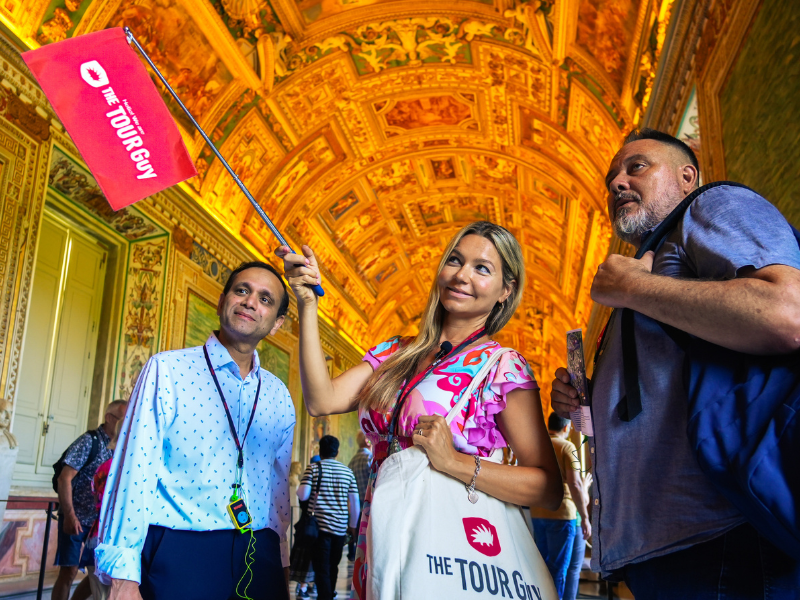
Exclusive Value
Vatican at Closing Time with Sistine Chapel
Exploring the Vatican during the day can mean massive crowds and enduring long lines. With skip-the-line access and an engaging guide, you’ll uncover the captivating stories behind the galleries and enjoy the awe-inspiring beauty of Michelangelo’s Sistine Chapel in a serene setting. Your friendly guide offers a rare perspective, allowing you to experience the Vatican Museums after most visitors have left, making your visit truly extraordinary.
See Prices
Not ready to book a tour? Check out our Vatican Guide for more info.
26. The Candelabra Gallery
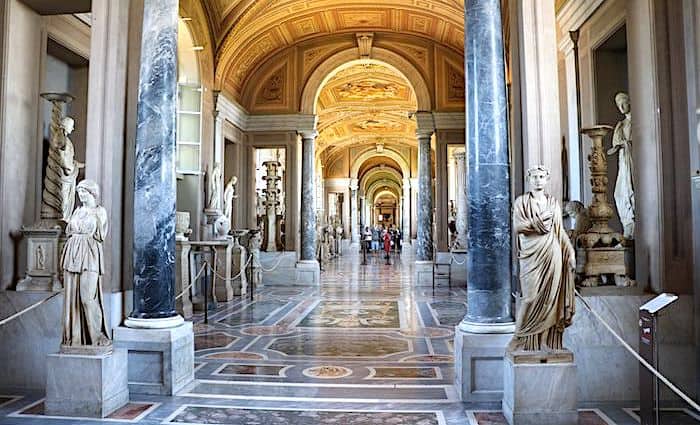
As the name suggests, the Gallery of the Candelabra is so called due to the enormous marble candlesticks that you can find in each section as you walk down the hallway.
The gallery was completely renovated during the pontificate of Pope Leo XIII Pecci (1878 – 1903) and that is what you see today. It was meant to be built so that each piece is like a furnishing for a house.
27. Artemis of Ephesus
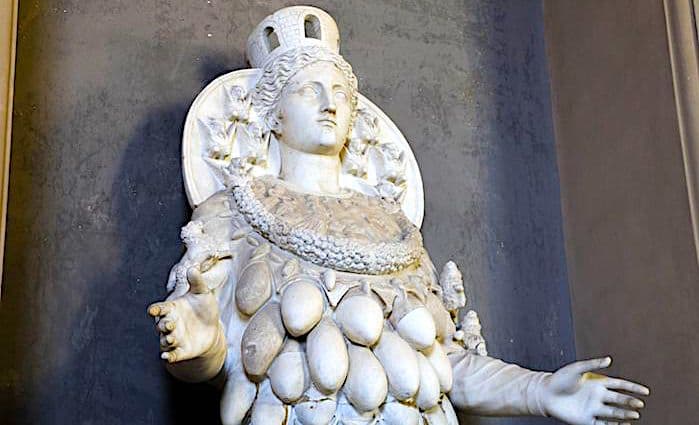
This piece is by far the most striking statue in this room and definitely the biggest eye-catcher. Many people will walk past the statue and you’ll hear them say, “Look at the multi-breasted statue!” Upon closer inspection, you realize that they are, in fact, bull testicles. Considering that Artemis was the goddess of fertility, what symbol resonates more with fertility than bull testicles?
The statue is one of many copies that you’ll find, which would have originated in Ephesus, Asia Minor in modern-day Turkey. Ephesus was a booming port city during the Ancient Roman Empire and even today is a huge archeological park. The city was dedicated to Artemis, and one of the biggest temples in ancient times was the Temple of Artemis. Inside the temple, there would be found these statues of Artemis with bull testicles.
28. Lapis Lazuli Mosaic
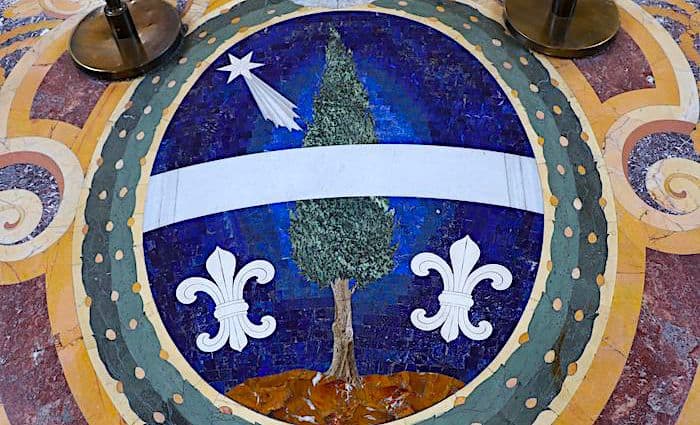
In the middle of the gallery, you will see a small, cordoned-off area protecting the mosaic on the floor. It’s impossible to miss it with the brilliant and rich blue colors. This is the papal coat of arms of Pope Leo XIII ( Pontiff 1878 – 1903). The papal coat of arms consists of the papal tiara, the two keys of St. Peter representing the divine world and the world here on earth. On the shield is his personal emblem of a shooting star, a cypress tree, and two fleurs de lis.
The background of the shield in this mosaic is blue from the precious stone Lapis Lazuli (blue stone in Latin). The stone originates mostly in Afghanistan and is still mined there today. In the Middle Ages, Europe started getting the stone for the first time and its powder, from which the color is used in painting, was considered the finest and most expensive of blue pigments. Michelangelo himself used it for his pigment of the blue color in the Last Judgement in the Sistine Chapel.
Leo XIII’s reign was interesting since it was the first conclave (election of a pope) that took place during the period of the Vatican being “occupied.” It was at this time that the country of Italy was forming and the temporal power of the Papacy was lost and therefore withdrew into the walls of the Vatican. Before the occupation, the Vatican actually ruled over other parts of Italy as their acting government.
In 1929, the Italian government and the Vatican created an accord that would allow the Vatican to become it’s own sovereign state and everything within the Vatican City walls, plus a few other buildings, became known as the smallest country in the world.
Curious how a new Pope is selected? Check out our article on What Happens When a Pope Passes Away?
29. The Persian Warrior
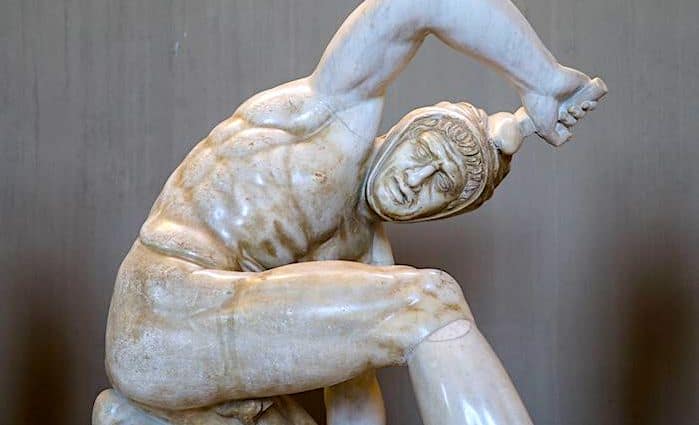
This statue easily identifies the person to be Persian by his Phrygian cap (conical-shaped beret). His body is in a defensive position, moving away from the blade of his enemy while he grabs his sword with his right hand to strike back.
The fear of defeat is beautifully captured on the face of the warrior as all seems to be lost. This Roman copy was probably made around the year A.D. 110 and would have been part of a series of statues in bronze that commemorated Greek victories over their enemies.
Attalos II of Pergamon made two sets of these votive statues with one set being placed in Athens on the Acropolis and the other in Pergamon itself, known as the statues of Little Barbarians. The original of this statue would have been part of a group of Greek victories over the Persians at the battle of Marathon in 490 B.C. This copy of the statue was discovered in Rome between 1503 and 1512.
30. Gallery of the Tapestries
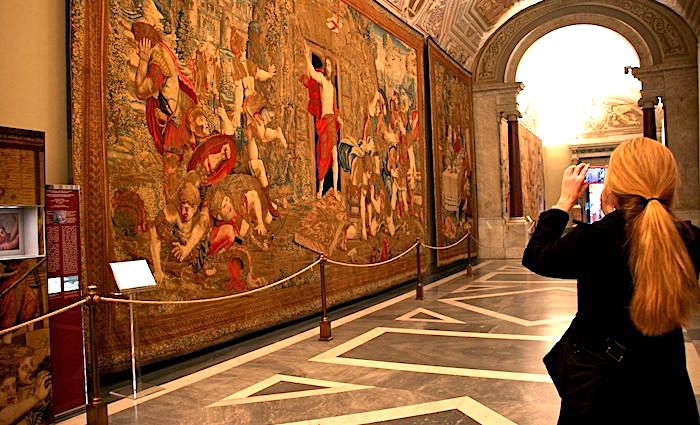
This room is filled with tapestries hung from ceiling to floor, hence the Gallery of Tapestries. What are tapestries? They are rugs whose original purpose was simply to keep a room warmer before the invention of centralized heating. This is why if you walk in the gallery today, it is always air-conditioned since the tapestries emanate a lot of heat.
As you walk down the gallery you will see tapestries on the right-hand side dedicated to stories of the life of the Barberini Pope Urban VIII (17th century). On the left-hand side, are stories from the Bible whose original drawings were executed by the school of Raphael, then woven in Flanders.
31. Resurrection of Christ
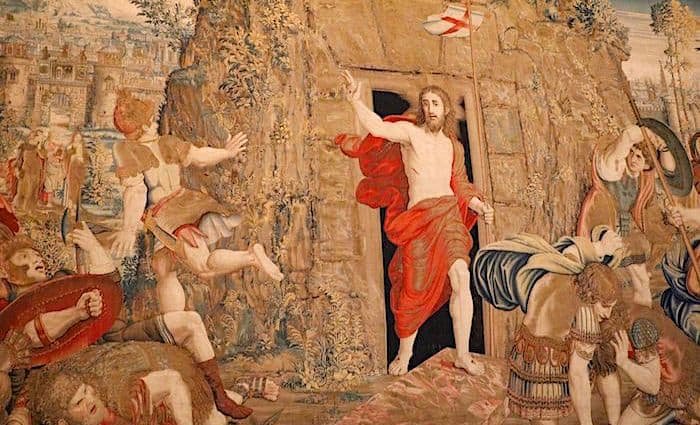
This tapestry was originally hung in the Sistine Chapel until it was moved to this gallery in the 1830s. Jesus stands on the stone that had closed up his burial and holds up his right hand with the three-finger sign of the holy trinity.
The Roman soldiers who had been guarding the tomb are all moved back in fear as they see Jesus literally coming back from the dead. His wounds are still fresh from where he was nailed to the cross and he has a look of complete calm and triumph with a light halo glow behind his head.
The Flemish designers decided to add a little something extra in this tapestry, however. With the tapestry on your left, find Jesus’ eyes and slowly start to walk past the tapestry. His eyes will follow you from one side to the other. The message was simple: no matter where you are, Jesus is always watching you!
32. The Gallery of the Maps
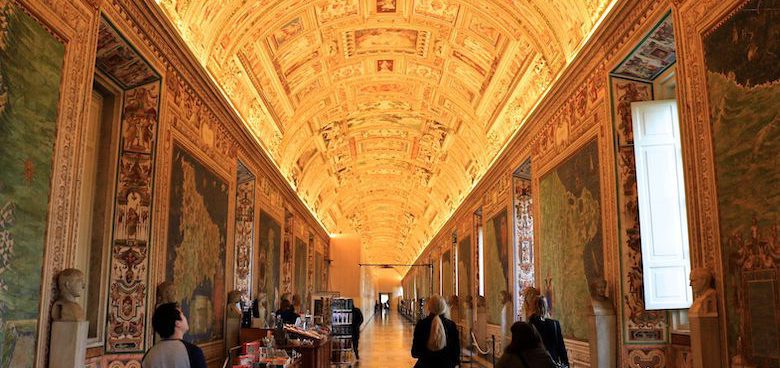
By far one of the most over the top as far as decoration goes, the Gallery of Maps is literally a gigantic mural with frescoes on both sides of maps depicting Italy. Pope Gregory XIII, also known as the calendar pope, commissioned this room to be painted so he could accurately study the lands in which he lived and the surrounding areas.
The pope is probably most known for giving us the Gregorian calendar, which fixed the errors of the Julian calendar, created by Julius Caesar 1,500 years earlier.
33. The Grotesques
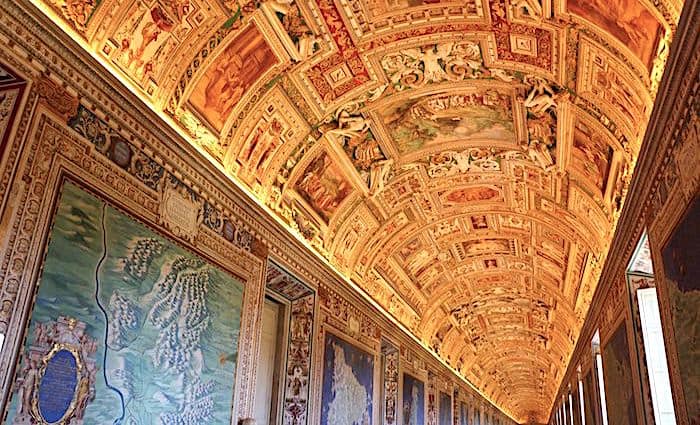
Walking down this Gallery, you will notice between each windowsill there’s a bizarre painting style showing vines, demon-like heads, and strange children. This painting style was called grotesque and was quite popular as decoration in the mid-16th century. The term comes from the Italian word grotta meaning “cave”.
At the beginning of the 16th century, artists like Raphael had discovered ancient Roman frescos around the area which was Nero’s Golden House. This particular style had a huge impact on these artists, including Raphael. Around the beginning of the 18th century, this decorative style fell completely out of fashion and that’s where today’s common meaning of the word “grotesque” comes from.
34. The Ceiling
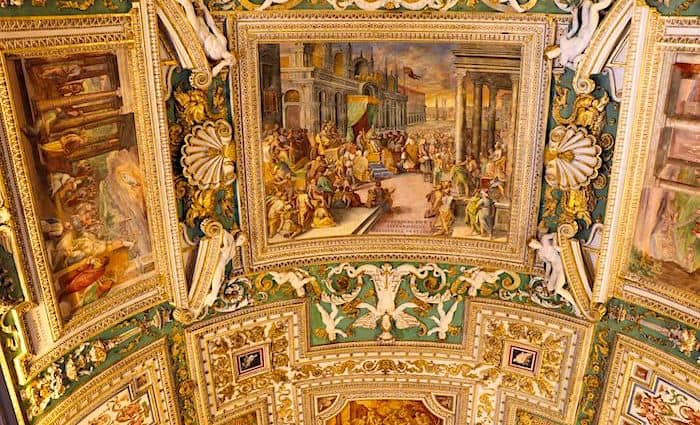
Imagine having to paint a ceiling that is 393 feet (120 meters) long. You not only have to paint it, but also decorate the rest of it with stucco and gold leaf. That is exactly what Ignazio Danti set out to do in 1580 together with artists Cesare Nebbia and Girolamo Muziano. In three short years, they were able to finish not only the ceiling but even the side frescos.
The ceiling is a mixture of saints, martyrs, apostles, and other important figures in Christianity. When you look up, you realize that the order of the paintings was meant to be looked at coming from the other direction, since the frescoes will be upside down to you. What is even more remarkable is that the figures in the ceiling frescos can be linked directly to the geographical positioning of the maps on either side.
35. Map of Sicily
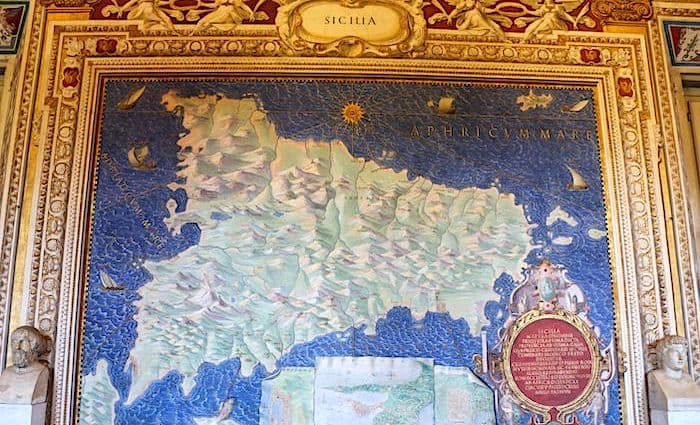
Many Italian-Americans can trace their lineage back to Sicily. When you look at the map you will see all the major cities that this bountiful island has. You will also see beautiful Taormina and the neighboring and still active Volcano Etna—it even shows some lava coming out of it on the map.
Many people will walk past this and never notice something extremely strange about the map: All of the cities are upside down! That’s because when Sicily was being painted, the pope asked that everything be arranged according to what it looked like as if you were looking at it from Rome.
36. Map of Lazio
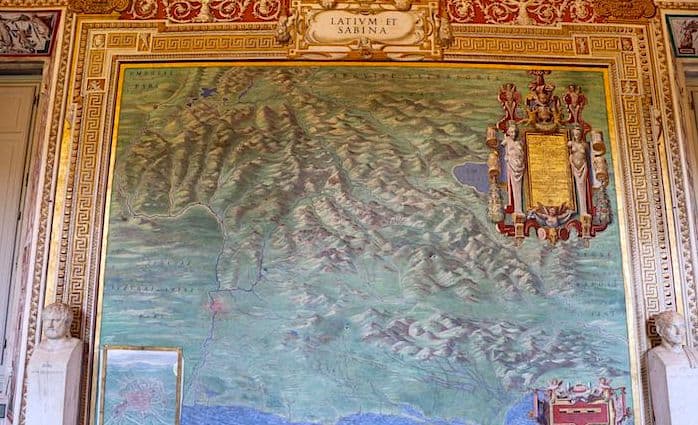
Lazio, or Latium in Latin, is the region surrounding Rome, the capital. In this map, you can see the entire region with a blow-up of the city of Rome itself in the bottom-hand corner. There are a few monuments that you can see there, which are still familiar to us today.
The most interesting one is St. Peter’s Basilica, which was still being constructed at the time. If you look closely, you’ll notice that there isn’t a square built yet with the huge colonnade. That will be built by Bernini, but not for another 50 years!
37. Vatican Radio Station
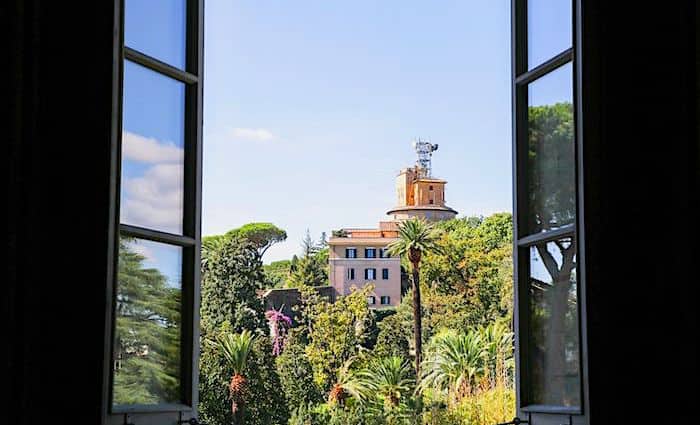
Midway down this gallery, on your right-hand side, you will see a set of windows that go from the floor to the ceiling. Take a look outside and you will not only get a great view of the Vatican Gardens, but you’ll also see a huge tower in the distance.
This is Radio Vaticana, the official radio of the Vatican State. Radio Vaticana was set up back in 1931 by Guglielmo Marconi. Today, the radio station broadcasts in 47 languages and is still maintained by the Jesuit order.
38. The Raphael Rooms
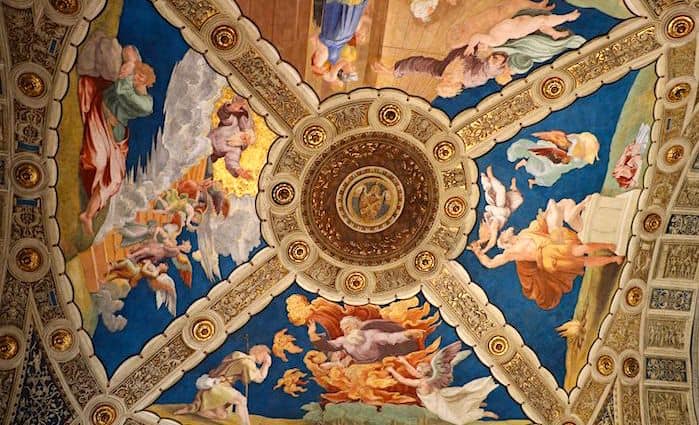
The four rooms known as the Raphael Rooms were painted by Raphael and his students between 1508 and 1524. They were commissioned first by Pope Julius II (1503 to 1513), supposedly because he refused to live in the Borgia apartments on the floor below due to his hatred for the man. These rooms were also used by his successors, specifically Leo X the Medici Pope (1512 – 1521).
Top Colosseum Tours
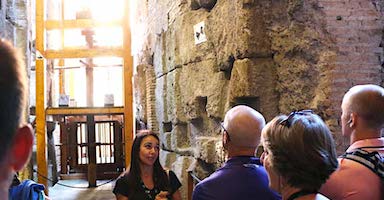
Best Seller
Colosseum Underground Tour with Roman Forum and Palatine Hill
Only 2% of visitors to the Colosseum are able to see the Underground, making tours a rare, exclusive experience. Our tours give you access to the Underground, Arena Floor, and first and second tiers—areas most people never see. Skip the line and enjoy priority access, guided by an expert who brings the Colosseum’s rich history to life. These spots sell out quickly, so don’t wait—secure your place now for this unforgettable opportunity.
See Prices
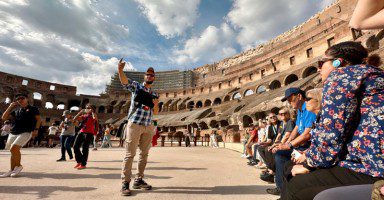
Customer Favorite
Special Access Colosseum Arena Floor Tour Through the Gladiator’s Gate
Reaching the Colosseum’s Arena Floor is no easy feat; tickets sell out quickly, leaving most visitors stuck in crowded corridors with limited views. With us, bypass the lines and enter through the Gladiator’s Gate to stand on the Arena Floor, giving you a front-row view of Rome’s nearly 2,000-year-old symbol of power and glory. With your friendly guide, uncover the Colosseum’s brutal past, then continue to the Roman Forum and Palatine Hill to explore the epicenter of ancient Roman life.
See Prices
Not ready to book a tour? Check out our Colosseum Guide for more info.
39. Room of Constantine
This was the last of the four rooms painted and, as a consequence, would have been painted primarily by Raphael’s students. The room’s name is in honor of the first Christian Emperor, Constantine the Great. His time in power had huge, positive implications for the church and its future.
40. Vision of the Cross
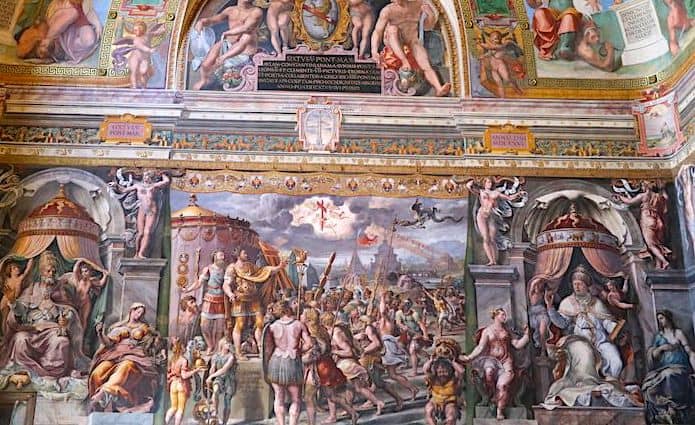
The night before the decisive battle against his enemy Maxentius, Constantine sees in the night sky a white cross burn across the sky. This premonition made it clear to him that if he replaced the emblem of eagles with the cross, he would be victorious
Interesting Note: In the foreground, you will see a midget holding up a helmet. This was actually the court jester of Pope Leo X!
41. Battle of Constantine Against Maxentius
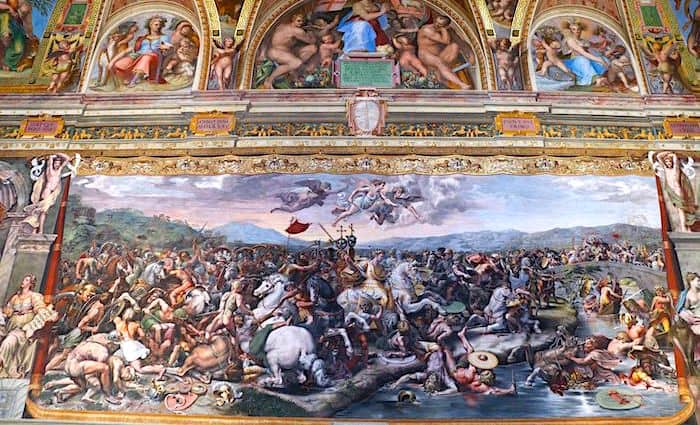
This is the ensuing battle after the previous night’s premonition with the cross. The battle takes place at the Milvian bridge (which you can still cross today) in the northern part of the city. This victory, in A.D. 312, is considered the first Christian Victory ever.
You can see Constantine, who is victorious on a white horse, with angels above his head and the defeated Maxentius on a brown horse in the river drowning.
42. The Victory of Christianity over Paganism (Ceiling)
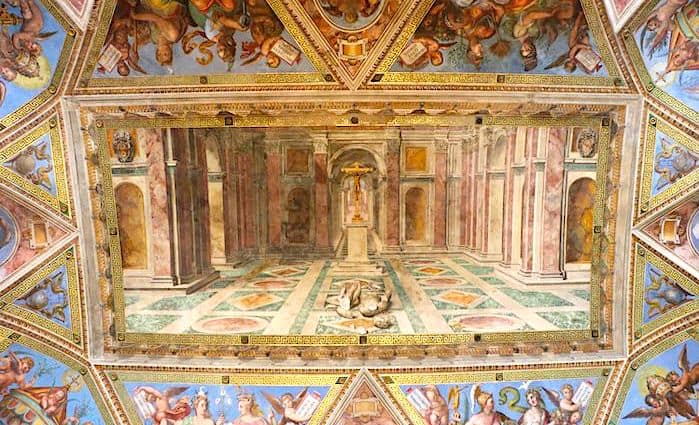
Missed by many people (Look up!), this painting was added later by the Sicilian painter Tommaso Laureti in 1585. If ever there was one picture to promote the expression “A picture paints a thousand words,” this is the one. You’ll see on a pedestal a Christian cross and at its feet a pagan statue that has been smashed to thousands of pieces.
43. Room of Heliodorus
The purpose of this room was originally for private audiences with the pope. The room’s theme is definitely political and aims to show not only the power of the church, but the political agenda of Pope Julius II who wanted all the foreign occupiers out of the Italian Peninsula.
44. Liberation of St. Peter
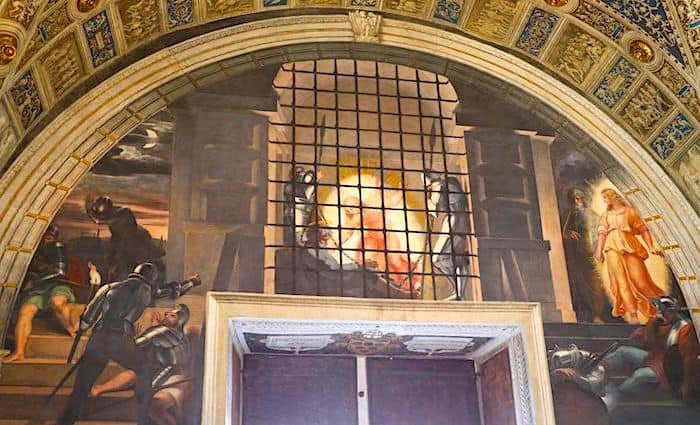
The story is about the first pope, St. Peter, who is a prisoner in Rome. In the evening, an angel comes and breaks his chains to set him free. Julius II commissioned this painting since, before becoming pope, he was the Titular Cardinal of St. Peter in chains in Rome.
This entire fresco is a brilliant display of light effects. As you look closely at the painting, you’ll notice first the extreme splendor of the light of the angel herself whose glow reflects the armor of the stunned prisoners in the room. Compare that with the light of the rising Sun to the left and also the natural light coming in from the window below.
45. Encounter of Leo the Great with Attila
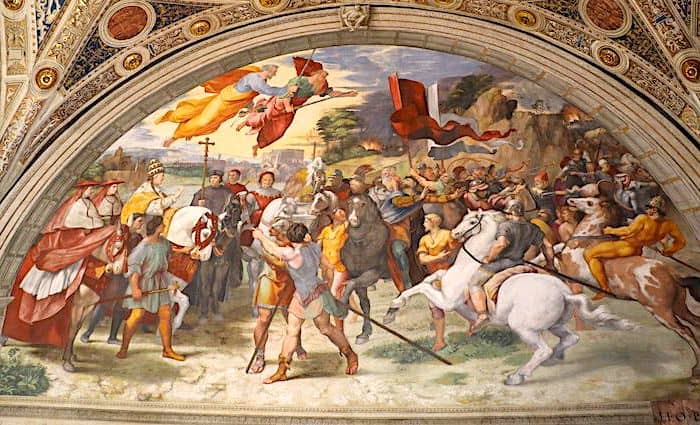
The painting depicts part of a real story in history when Attila the Hun made his way to Rome in A.D. 452 and stopped at the gates of Rome. Historically, it appears that the city, already decimated and plundered many times over at this point, had no defense against Attila. So, just Pope Leo I went out to greet him. After the discussion, Attila turned his group of warriors back and never sacked Rome.
According to the legend and also depicted in these paintings, during the encounter Saints Paul and Peter were by the pope’s side and scared him so much that turned his army around. You will see the pope in a very calm manner expelling the barbarians from Rome, while the Barbarian King is scared out of his mind upon seeing the angels and leaves hurriedly on his horse.
Interesting Note: Julius II died during its painting and Leo X took over as pope. This is why you will see Leo X’s face twice, once as the cardinal and then as the Pope himself.
46. Room of the Segnatura
This room was originally used by Pope Julius II as his private office and library, but in the mid-16th century became the room where the pope would sign important documents, hence the name Segnatura or “signing”. This room was also the first room where Raphael started painting and became the most famous.
Curious how a Pope is selected? Check out our article on What Happens When a Pope Passes Away?
47. School of Athens
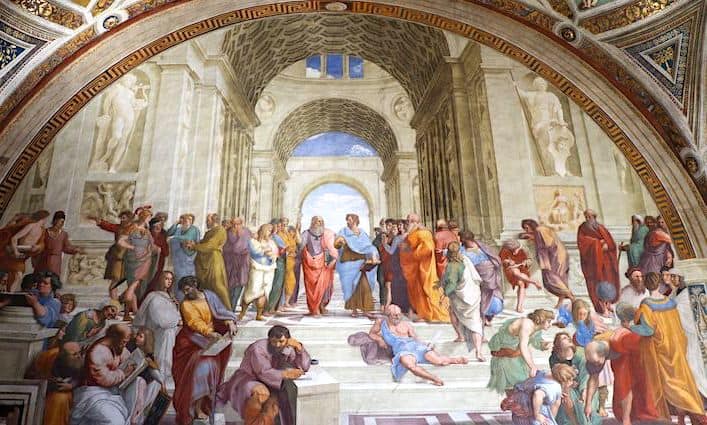
Easily one of the most famous paintings by Raphael and the one that established him as one of the most famous High Renaissance painters in the world. The painting, for our purposes, is actually famous for two reasons.
The first is that it is the peak of High Renaissance painting in that it is harmonious, symmetrical, and celebrates ideal beauty in all its forms. The second reason is that this painting is basically a yearbook of the most famous artists of the early-15th century, depicting their real faces
The Renaissance was the rebirth of classical philosophy, classical literature, and classical thought overall. Once the Roman Empire fell, Europe fell into a 1,000-year dark period where civilization went backward and learning was left as an afterthought.
After the fall of Constantinople in the middle of the 15th century, many scholars fled to Italy and were welcomed in Tuscany. As a result, they brought with them many texts (and the learning of ancient Greek) and reintroduced many of the ancients to Italy.
Interesting Note: Raphael used the faces of his friends as models for some of the famous people. Leonardo Da Vinci is Plato pointing a finger in the air. Bramante is Euclid, who is bending over a chalkboard and Raphael puts himself in the painting on the far right side staring directly at us.
According to legend, as he was painting this room, Michelangelo was painting the Sistine Chapel. One day Raphael got a peek of what Michelangelo was doing and was so impressed that he came back upstairs and broke a piece of plaster off the wall and put the face of Michelangelo as a tribute to how good he was.
48. Room of the Fire in the Borgo
During the time of Pope Leo X, this room was used as his personal dining room and the current bathroom next door was used as the kitchen. This room was mostly decorated by Raphael’s students, and the themes of the paintings were taken from the lives of the other great popes named Leo.
49. Fire in the Borgo
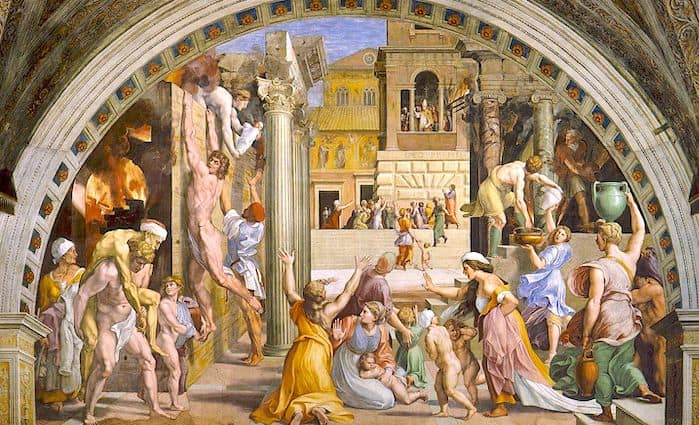
This painting shows a story from the “Liber Pontificalis” that spoke about a huge fire breaking out in the Borgo (the area around St. Peter’s church) in 847. The story relates that everyone was in a panic and Pope Leo IV (847 – 855) walked out on the balcony of his palace solemnly and blessed the fire whereupon it was immediately extinguished.
Interesting Note: When you look at the figures in this painting, the first thing that jumps out at you is the extreme amount of muscles that everyone possesses, including the kids. By this time, the Sistine Chapel had been unveiled and Michelangelo’s muscular figures had become famous, so the students of Raphael also attempted this, but as you will see they should have studied anatomy a bit more.
Popular Tours from Rome
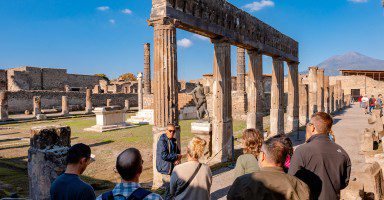
Best Seller
Unforgettable Rome Day Trip to Pompeii and Sorrento
Making a day trip from Rome to Pompeii and the Amalfi Coast can be daunting, with long travel times, complex routes, and tricky logistics to manage. Our full-day tour eliminates the stress, offering comfortbale transport straight to Pompeii. With an archaeologist guide, explore the ancient ruins without the hassle. Then, unwind with free time in Sorrento’s coastal charm. Led by a local guide and small group, this trip makes experiencing Italy’s highlights easy and enjoyable—all in one day.
See prices and more info
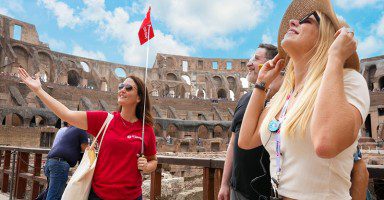
Best Seller
Rome in a Day Tour with Colosseum & Vatican Museums
Seeing the best of Rome in a single day might seem like a big undertaking, but our expertly designed tour makes it effortless with skip-the-line tickets, included transportation, and engaging guides to lead the way. In just 7 hours, you’ll visit renowned sites like the Sistine Chapel, Colosseum, Trevi Fountain, and Pantheon. With fascinating stories at every stop, you can skip the stress and immerse yourself in the vibrant heritage and culture of Rome all in one remarkable day.
See prices and more info
Not ready to book a tour? Check out our Rome Guide for more info.
50. The Sistine Chapel
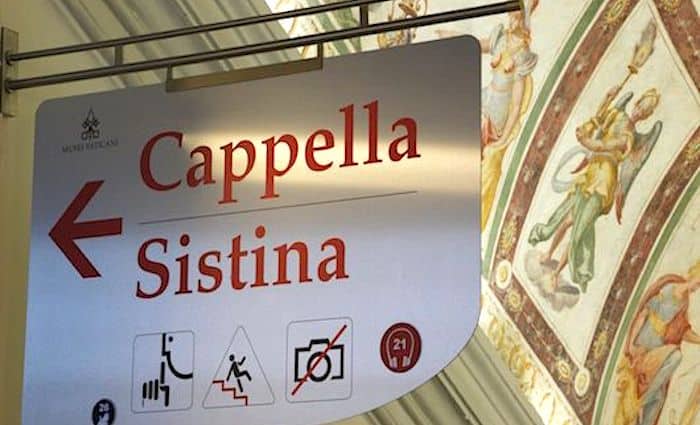
The Sistine Chapel needs no introduction. Originally named Capella Magna (Great Chapel), it was restored by Pope Sixtus IV (pontiff from 1471 to 1484) in 1480. Sixtus IV had famous early-Renaissance artists who lived a generation before Michelangelo and Raphael paint the fake draperies, the life of Moses and Christ (side walls), and the pope (above the windows) Sixtus’ nephew. Julius II had Michelangelo in turn paint the ceiling in 1508.
In 1533, Clement VII commissioned Michelangelo again to paint the back wall with the Last Judgement. Did you think that was it? C’mon guys this is the ultimate guide. I will now go into detail about each segment. Stay with me!
51. The Ceiling
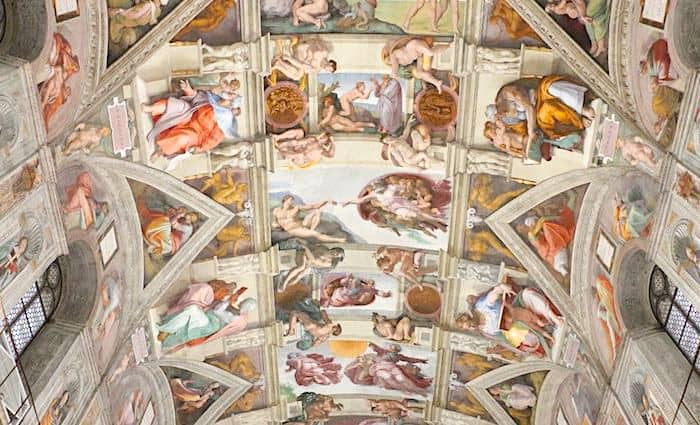
Julius’ decision to repaint the ceiling probably had to do with structural damage done during the excavations for the Borgia Tower and the new St. Peter’s Basilica. At the time, Michelangelo was working on the pope’s tomb and seemed to be quite content with this.
The Artist: Michelangelo
As the story goes, Bramante, who was upset with Michelangelo for a previous slight, suggested to the pope that Michelangelo should paint the ceiling even though he was a sculptor and not a painter. Julius agreed and Michelangelo, pretty much against his will, signed the contract to paint the ceiling. The original design was to be the twelve apostles, but after Michelangelo objected, Julius put the design in the master’s hands and the rest is history.
Michelangelo had many problems/hardships going into this job. Let’s name a few so you get an idea:
- He was a sculptor, not a painter.
- Having never really painted in this medium, his first attempt at fresco painting basically resulted in the most famous painting in the world.
- He had to build his own scaffolding before he could even reach the ceiling, which was 60 feet high.
- Since he was a perfectionist, he basically painted the entire thing by himself.
- There was no centralized heating, so he complained of stifling heat in the summer and numbing cold in the winter.
- He developed an eye disease during the painting, which only went away once he finished the ceiling years later.
The ceiling is broken down into Central Panels, Sibyls and Prophets, Christ’s forefathers, and four corner stories.
52. Central Panels
Separation of Light from Darkness
While we take this for granted, imagine how epic it actually was to separate these two entities. Before there was just a big jumble of nothing and then boom: We have both light and darkness. Here, God is shown in a twisting motion separating light from darkness.
Creation of the Sun, Moon, and Planets
Michelangelo combines the third and fourth days of Genesis here, creating the vegetation in the left panel and with a commanding gesture and serious face, creating on the right-hand side the Moon and the Sun.
Separation of Land from Sea
Flying up high in the sky, God separates the waters from the land itself. Like the painting above in separating light from darkness, this is another epic moment in time. Imagine the world before this event happened, it would have been complete chaos!
Creation of Man
Probably the most famous and reproduced painting on the planet, God is breathing life into Adam who is in a reclining position and embodies the perfection as described in the old testament of a man being an imitation of God himself.
A magical enigma here is that the hands between the two almost touch, but don’t. Many art historians point to this painting as having significant allegorical connotations between Michelangelo and his father. Their relationship had always been very rocky due to the fact that his father never truly approved of his profession. In not allowing their hands to touch, he shows his father’s dissatisfaction with him.
Creation of Eve from the Body of Adam
In the book of Genesis, we have the following about the creation of Eve: “So the Lord God caused a deep sleep to fall upon the man, and he slept; then he took one of his ribs and closed up its place with flesh. And the rib that the Lord God had taken from the man he made into a woman and brought her to the man.”
Here you see Eve springing to life from what looks like a sleeping Adam, as God beckons her to him.
Banishment from the Garden of Eden
Michelangelo shows two scenes here with the first scene on the left side interpreting original sin. In this scene, they are young, healthy, and beautiful. They are still perfect beings without any sense of shame or wrongdoing. The serpent is in the tree and suggests to Eve that they eat the forbidden fruit. Eve tells adam to eat it and in so doing they have disobeyed God.
At that point, the scene on the right shows what happens next. First of all, they become aware of their nudity and of the fact that they are humans. They are therefore banished from the Garden of Eden and the contrast in their figures from those on the left is astounding. They have horror in their eyes and the expression on their face explains exactly how you would feel when banished from paradise. Michelangelo would have been heavily influenced in this painting by the artist Masaccio whose painting the master would have seen in the Brancacci chapel in Florence.
The Sacrifice of Noah
In the bible it says: “Noah built an altar to the Lord; he took one of each kind of ritually clean animal and bird and burned them whole as a sacrifice on the altar. The odor of the sacrifice pleased the Lord.”
In biblical chronology, this actually happens after the flood, but it is probable that Michelangelo wanted more space for the Flood, since that painting was to be such an epic scene. So, this was put before it. The story is of sacrifice to God after surviving the flood, as mentioned above.
The Flood
In the Bible, it reads: “Now the flood was on the earth forty days. The waters increased and lifted up the ark, and it rose high above the earth.”
God decided to create a flood for 40 days and nights to destroy all the evil in the world and commanded Noah to build an ark of gopher wood and get a pair of all animals. Michelangelo displays this epic event not only of the ark, but also of various vain attempts of others to survive, either by climbing up a hill or scrambling onto a boat. In the end, they will all perish except for Noah’s ark.
The Drunkenness of Noah
In the Bible, it says: “When he drank some of its wine, he became drunk and lay uncovered inside his tent. Ham, the father of Canaan, saw his father naked and told his two brothers outside.”
In this last panel, Noah planted the grapevine and created wine from which he got drunk and fell asleep. His one son mocked him, while his two other sons cover up his nakedness without looking at him.
Interesting Note: For the best viewpoint of the entire ceiling, go all the way to the opposite side from where you came in after you walk into the chapel. There you will enjoy the best viewpoint. You will also notice that the three paintings of Noah were actually the first three Michelangelo worked on, so he made them too crowded and the figures too small. Compare these three with the other six and you will see a huge difference.
Sibyls and Prophets
The prophets represented here are taken from the Old Testament and foretold the coming of Jesus. The Sibyls were ancient, pagan priestesses, who due to their gift of foretelling the future, extended the wait for Redemption from the chosen people to all mankind. Starting from the entrance of the Sistine Chapel when you enter:
- Jonah
- Libyan Sibyl
- Prophet Daniel
- Cumaean Sibyl
- Prophet Isaiah
- Delphic Sibyl
- Prophet Zechariah
- Prophet Joel
- Erythrean Sibyl
- Prophet Ezekiel
- Persian Sibyl
- Prophet Jeremiah
53. Four Corner Stories
These four stories speak about episodes that saved the people of Israel. They are a testament to the constant vigil of God over his people and the promise of eventual redemption. They are placed here in the corners as meeting points for the stories on the ceiling and those of the walls.
Judith and Holofernes
According to the Bible, the city of Bethulia was being besieged by the Babylonian king Nabucodonosor. To save her city, Judith came to his tent in the night and when he was overcome with wine, she cut his head off. She then put his head on a plate and showed it to his soldiers and in doing so saved her city. Michelangelo breaks this up into three scenes of the sleeping guards, the head on a plate, and the beheaded King.
Punishment of Haman
Haman was the right-hand man of King Xerxes. He had declared that all the Jews be banished, since his main enemy, Mordecai, was Jewish. However, Mordecai’s cousin Esther was the mistress of the King and, in the end, switched things around so that the King killed Haman instead. You can see in the foreground, Haman being crucified with Esther and Mordecai watching with the King, who is the background, ordering the execution.
Brazen Serpent
During the escape from Egypt, Moses’s followers started to complain about him and God. So, God sent snakes to kill many of them. Once the people repented, God told Moses to make an image of a snake and all who looked at it would be cured. On the right-hand side, there is the dramatic scene of many people being destroyed by these snakes and in the background, the bronze serpent, made by Moses, protecting people.
David and Goliath
This is one of the more famous stories in the Bible. Goliath, a giant, is struck down by a much smaller-in-stature but much bigger-in-heart David. Michelangelo is showing us the moment when David is about to strike the giant and behead him. David is straddling him with his sword high in the air and the terrified Goliath accepts his fate.
The Side Panels
Above the painted tapestries, but below the windows, are masterpieces by early Renaissance artists who were painting the generation before Michelangelo and Raphael. They were commissioned by Sixtus IV and were meant to explain, on one side, the life of Moses and, on the other, the life of Jesus, which shows the continuity from the Old Testament to the New.
54. The Life of Moses
There are currently six paintings about the life of Moses on the side walls (when you walk into the chapel on your right)
The Journey of Moses in Egypt (Pietro Perugino)
As in most of these side panels, there are multiple scenes in this painting. Moses spends 40 years in the land of Midian after killing an Egyptian. After these 40 long years, God gives Moses a sign to come back to Egypt to save his people from the excesses and tyranny of the Pharaoh.
The next scene shows a story from the book of Exodus where God has threatened Moses. At that point, Moses’s wife, Zipporah, rushes to sacrifice an animal in order to save Moses from death.
On the lower right-hand side of the painting Moses’s baby son, Eliezer, is in the process of being circumcised by his mother Zipporah who is a Midianite. In the center of the painting, Moses is stopped by an Angel, which was usually a sign of God.
Events in the Life of Moses (Sandro Botticelli)
This fresco shows various episodes about Moses’s youth from the book of Exodus. There are three scenes and the story goes from right to left. The first scene is when Moses kills a man for insulting an Israelite and then flees into the desert in Midian.
The next scene is when he fights off a group of shepherds who refused to let the daughters of Jethro water their flock at the well. One of those daughters was Zipporah who would eventually become Moses’s wife. You will notice in this scene the beautiful woman with blond hair, who was a staple of Botticelli’s paintings.
The final scene starts on the top-left side of the painting where Moses hears the voice of God and removes his sandals. He approaches the burning bush where the voice of God tells him to return to Egpyt and announce to everyone that he will be freeing the Jews from slavery.
Passage of the Red Sea (Biagio d’Antonio / Cosimo Rosselli)
It is not certain if the painter of this was Cosimo Rosselli or his assistant Biagio d’Antonio, so we will give them both credit. This epic story in the Bible, which is also one of the most famous in the Old Testament, shows how Moses escapes with all his followers and they come to the Red Sea.
The Egyptian warriors are close on their heels, and it looks like a dead end, but Moses prays to God who parts the waters of the Red Sea. Moses and his followers proceeded to walk through the sea on dry land. The pharaoh’s army proceeds as well, but after the last of Moses’s followers make their way through, the waters come crashing down and destroy the entire army.
Handing Over the Tablets of the Law (Cosimo Rosselli)
This painting continues stories from the book of Exodus with three more from the life of Moses. In the first one, in the back corner of the painting, Moses is on the top of a mountain. He is kneeling down in front of God who has appeared before him and is giving him the tablets of the law.
The next scene is when Moses has returned from the mountain with the tablets of the law and finds that many of his followers have reverted back to worshipping pagan idols, in particular that of the Golden Calf. Moses is so upset that he breaks the tablets on the ground and punishes those idolizing false gods. He later receives new tablets of the law.
One interesting scene in this painting encompasses the entire idea of the Renaissance. Remember that the point of Renaissance painting was to show ideal beauty? In the foreground, with all the chaos of Moses happening, the painter decided to add a couple holding hands and looking quite happy, impervious to all that is going on around them. Some say that the man, who is wearing a red hat, is actually a self-portrait of Cosimo Rosselli (rosso means red in Italian).
Punishment of Koram, Dathan, and Amiram (Sandro Botticelli)
The wanderings through the desert lasted 40 years. At one point Korah, Dathan, and Abiram revolt against Moses and his leadership. They are punished by God with the earth swallowing them up along with 250 of their followers.
On the right-hand side, you see Joshua who is protecting Moses from getting stoned by the crowd. In the center, Aaron has his leadership questioned and is being attacked. On the left-hand side of the painting, Moses calls on God to punish the rebels.
In the middle of the painting, is a gigantic arch, which is a real interpretation of the Arch of Constantine in Rome. Constantine was seen as the first Christian Emperor and was therefore revered by all later Christians. He legalized the religion as well, so you can imagine the joy of a people who had been suppressed for the last 300 years to finally have religious freedom.
Legacy and Death of Moses (Luca Signorelli)
This painting portrays the final episodes in Moses’s life. There is also controversy about whether Signorelli really painted this or not. Giorgio Vasari, who was the leading biographer of the day, was convinced that he did, while many art historians today believe that it was actually Bartolomeo della Gatta.
On the right-hand side, there is Moses reading to his followers. At his feet is the ark of the covenant where the tablets of the law are stored. In the middle, Moses is conferring power onto Joshua who will take over God’s flock. Moses is speaking with an angel in the background, who is showing him the Promised Land, which he will never get to see because he dies beforehand. In the back-left corner, his followers are lamenting his death.
55. The Life of Jesus
There are currently six paintings about the life of Jesus on the side walls (when you walk into the chapel on your left)
Baptism of Christ (Pietro Perugino)
The first painting shows the real beginning of Jesus’ journey to become the Messiah. On the right-hand side, you see John the Baptist speaking with a crowd, while in the back left, you can see Jesus preaching to a different crowd.
The main attention is drawn to the center of the painting. Here, John the Baptist pours water over the head of a pious Jesus. There are crowds on both sides of the painting watching the event and, interestingly enough, they are all dressed in Renaissance-style clothes of the period. Above, you see God watching over the entire proceeding.
In the background, there are other scantily clad men, who it would seem are waiting to be baptized after Jesus. Perugino’s mastery of perspective is also on display here as the painting reveals a castle in the background and then goes even further back to show distant mountains and what looks like a lake. Raphael, who was Perugino’s student, was very fond of using this kind of background.
Temptations of Christ (Sandro Botticelli)
The devil tempted Jesus many times to try and break him from his attempt to become the Messiah. In the upper left corner, Satan is disguised as a hermit and asks Jesus for a miracle to test him. In the center background, Satan tries to get Jesus to jump off the temple. The temple resembles the construction of the Santo Spririto church by the Vatican, which Sixtus IV was building. The last scene is on the right-hand side where Jesus throws Satan off of a cliff.
In the center of the painting, there is a sacrificial rite taking place. This interpretation usually refers to the leper who, after he was healed by Jesus, made a sacrifice in his honor. Some art historians see this scene as allegorical with the older priest being Moses and the young man being Jesus. The sacrifice is that of Jesus himself making the ultimate sacrifice for mankind.
The Calling of the First Apostles (Domenico Ghirlandaio)
The famous biographer Giorgio Vasari wrote: “Domenico represented Christ calling Peter and Andrew from their nets, and the Resurrection of Christ, the greater part of which is now destroyed, for it was above the door.” The destruction of the wall ensured that the Resurrection was completely gone after.
The entire painting is focused on Jesus anointing St. Paul and St. Peter, who are both kneeling in front of him. On the right-hand side of the painting is a group of people who were actually the leading Florentine families of the time with residences in Rome. What’s interesting is in the center is Giovanni Tornabuoni who represented the Medici family. He was actually made the pope’s treasurer and later became a patron to Ghirlandaio himself.
The Sermon on the Mount (Cosimo Rosselli)
This painting runs parallel with the opposite wall where Moses is receiving the tablets of the Law. The center focus of the painting is Jesus on the mount preaching to his disciples. What is happening, allegorically, is that Jesus is becoming the new Moses, passing on the teachings of God and continuing Moses’s work.
In the foreground, you can see Jesus on top of the mount and preaching to his followers. This is the main subject of this painting and all of the other attributes of it center around this part of the painting. On the right-hand side, Jesus heals the leper with many onlookers. Remember that since this is a Renaissance painting, the artist is more concerned with the ideal beauty of the event and not the event itself, per se.
Handing Over the Keys (Pietro Perugino)
I’m going to go out on a limb here and say that this is the third most famous painting in the chapel after the ceiling and the Last Judgement. Perugino is able to create extreme depth in the painting by his expert use of perspective here. In doing so, he created three layers of composition.
In the foreground and the most important scene, Christ stands in front of a kneeling St. Peter. On both sides of them there are the usual group of onlookers as in the other paintings at the event with almost disinterest but in line with the standards of the time. Peter receives the two keys (the gold key is that of Heaven and the silver is that of Earth) from Jesus.
Behind them, there is a massive piazza, which is not based on any real place, but more of an “ideal piazza.” From a distance, it actually looks like people are ice skating, but they are getting ready to stone Jesus. In the background, there are two arches—replicas of the Arch of Constantine, which again plays an important role in Christianity since he was accredited as being the first Christian Emperor. Finally, in the background, you can see hills off in the distance, exemplifying Perugino’s use of perspective.
The Last Supper (Cosimo Rosselli)
Many people think that there is only one Last Supper painting and it’s by Da Vinci. In fact, the Last Supper was quite a popular theme for paintings and hundreds of them exist. Each portrayal of the Last Supper has its own particular characteristics and this one by Cosimo Rosselli is no different.
In the painting, Jesus has just shared the news that he is going to die after passing around the bread and some wine. The faces of the apostles don’t have many expressions of surprise on them, because as it has been mentioned, the focus was on ideal beauty in the Renaissance, which was more important than the actual event taking place. The only apostle on the other side of the table is Judas, who is already holding a sack with silver coins for his betrayal to tell the Jewish elders who Jesus was.
Above everyone, there are three windows, which, instead of showing some background, allude to the three events from the Bible that occur next. From the left, there is first the prayer on the mount of olives, then the betrayal, and finally the crucifixion. A side note: remember that Cosimo Rosselli’s last name derives from the word “red”—there’s a man in the right-hand corner who is looking right at us with a red hat on!
56. The Last Judgement
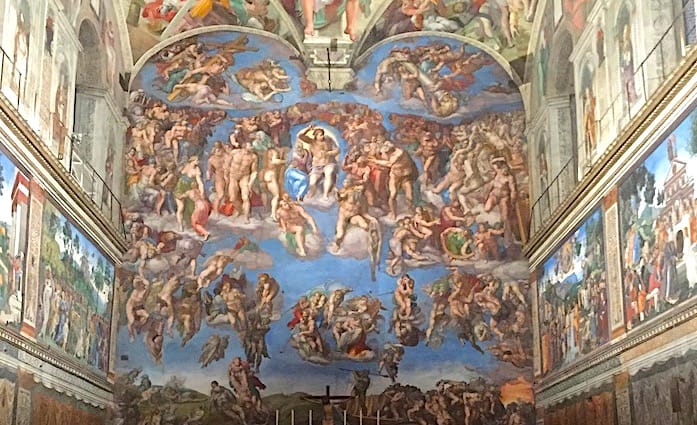
This fresco was one of the last additions to the Sistine Chapel (finished in 1541) and was painted by none other than Michelangelo himself. By the time this painting was finished Michelangelo had spent almost 10 years of his life in the Sistine Chapel painting the ceiling and back wall. The master continues to portray people with huge muscles as he did with the ceiling. The entire art piece is a whopping 42 feet (13 meters) high and 39 feet (12 meters) wide. It took Michelangelo five years to paint.
Upon ascending to the throne of St. Peter, Pope Paul III (Pontiff 1534 – 1549) was leading a church in a time of great crisis. The major sack of Rome (1527) had been just 7 years earlier and was still fresh in the minds of many. He was also facing increasing external pressure as Protestantism was in its infancy. What better way to fight back the critics and take control of the church than with a painting about our ultimate salvation?
The Story
In the Last Judgement, all of the sinners will be sent down to Hell’s eternal fire and all of those who believe and repent will be allowed to enter the Kingdom of Heaven. The world is basically ending at this point for the majority of us. Michelangelo portrays this perfectly and adds many elements of classic literature as well.
The Top
In the upper lunettes, you can see angels carrying instruments used during the Passion of Christ (the cross, the whip, the column he was whipped on, and the crown of thorns). Below that, you’ll see an extremely muscular Jesus with no beard in a powerful position presiding over the entire scene with a radiant halo bursting behind him. Figures that are recognizable include John the Baptist, the Virgin Mary, St. Peter holding the keys, and various other saints holding the instrument with which they were martyred in their hands.
Interesting Note: Below Jesus, you will find St. Bartholomew who was skinned alive. In his right hand, he is holding a knife and in his left hand his own skin! Many contemporaries suggested that Michelangelo did a self-portrait in the skin.
The Middle
Here, you can see a group of angels blowing trumpets and holding two books with the bigger one holding the names of those damned and going down to Hell with the smaller one having the names of those who are redeemed and going up to Heaven. Those on the left-hand side, the redeemed, are being brought up from their graves. There are even fights breaking out with demons who are trying to hold onto the ascending bodies, but the angels are pushing them back to the Underworld.
The Bottom
Here, Michelangelo alludes to Greek mythology with the demon (Charon) on a boat bringing all the damned souls over to the Underworld. On the far right side, you will see the Devil himself and all the damned and lost souls behind him in Hell.
Interesting Note: When the painting was unveiled, many were shocked by the amount of nudity in the painting. Biagio da Cesena, a Cardinal, said that this was better suited for a tavern than the holy chapel of the pope. It is said that Michelangelo then changed the face of the devil to that of the Cardinal and wrapped a snake around his body and biting him in the groin area.
Popular Vatican Tours
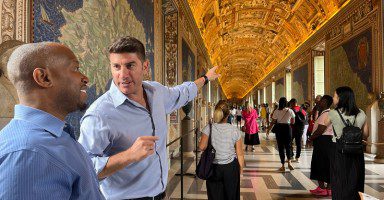
Best Selling Tour
Privileged Entrance Vatican Tour with Sistine Chapel
Without the right access, visiting the Vatican means fighting crowds, long waits, and missing the most significant rooms and works of art. Our privileged entrance tour offers more than just entry—it’s an immersive experience led by a storytelling guide who brings the Vatican to life. Skip the line and explore the Vatican Museums, including the Raphael Rooms, the Sistine Chapel, and St. Peter’s Basilica with engaging insights that make each moment memorable and meaningful.
See Prices
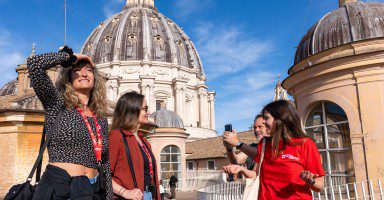
Top Rated Tour
Ultimate St. Peter’s Basilica Dome Climb and Tour with Papal Tombs
Visiting St. Peter’s Basilica and its dome on your own can mean dealing with crowds and waiting in line for hours. Our early-morning tour, led by a captivating local guide, ensures you skip the hassle with privileged access and insider knowledge, including the best times to climb for awe-inspiring views. Explore the stunning Basilica, take in breathtaking panoramas, and descend into the sacred Papal Crypts for a truly immersive experience.
See Prices
Not ready to book a tour? Check out our Vatican Guide for more info.
57. St. Peter’s Basilica
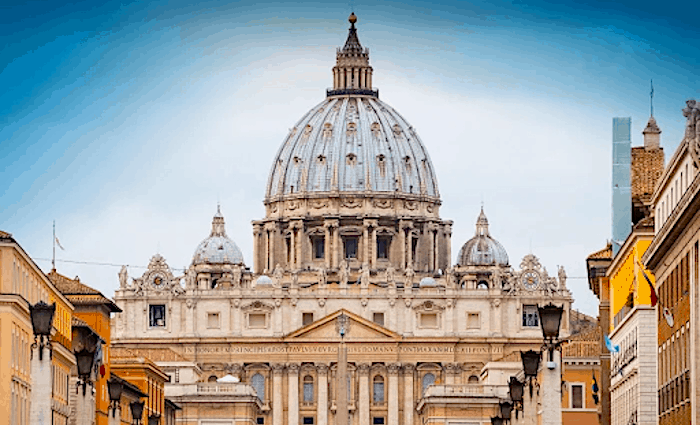
For me personally, there is no church that compares in beauty. St. Peter’s Basilica is the ultimate expression of space, beauty, and monumental grandeur. It also happens to have an amazing history to it as well, so let’s get into it.
According to legend, St. Peter was in Rome during the Christian persecution of A.D. 64 under the emperor Nero. He was caught up in the frenzy and was martyred by upside-down crucifixion (see above painting by Guide Reni). At that time, there was the Circus of Nero where the church stands today. A circus, back in the day, was where they held chariot racing. It was in this area that St. Peter was said to be buried along with other Christians and pagans alike, in a nearby necropolis.
58. Constantine’s Church
When Emperor Constantine the Great legalized Christianity, he wanted to help the Christians by giving them back land that was taken from them and also had many churches built. His masterpiece, however, was the church he wanted to build on the Mons Vaticanus over the tomb where St. Peter was buried.
The undertaking was huge, considering that the area was not flat and there was also a functioning necropolis on the site. To fix the slope, he ordered 1,500,000,000 cubic feet of blue clay to be brought from the top part of the hill to the lower part to even out the area. That is the equivalent of 40 Houston Astrodomes or 17 Giza Pyramids. For the necropolis, he simply filled the area with dirt to make it more stable. Work started around A.D. 330 and took 30 years to build.
We know the makeup of the church today due to the many drawings and paintings from artists of the time. Early on in its history, it usually functioned as a funerary church, meaning it was used almost exclusively for funerals. Popes would rarely conduct mass inside. This changed as the centuries progressed and from the time of Charlemagne’s coronation as emperor inside (A.D. 800), its prominence rose.
The church had three archways, which opened up to a courtyard that was so beautiful it was called paradise. Here, there would have been a huge fountain with a bronze statue of a pine cone (now visible in the Pinecone Courtyard in the Vatican museums). After that, you would enter from one of the five doors into the basilica itself, which had five naves divided by massive Corinthian columns. A testament to Constantine’s brilliance is that his church stood for 1,200 years.
59. Current St. Peter’s Church
By the mid-15th century, it was obvious that the church needed to be rebuilt as it was beyond repair at this point. Luckily, it just so happened to be the Renaissance times with the most gifted builders and artists the world had ever known! The construction of the new church would take roughly 120 years, spanning the reign of 20 popes and involved pretty much every famous Renaissance architect and artist.
The work was officially started by Pope Julius II (who commissioned Michelangelo to paint the ceiling of the Sistine Chapel). The architect was Donato Bramante, who was the most capable architect of his time. While many recommended just fixing certain areas, Bramante decided to demolish the majority of the basilica and build ex novo (from scratch).
Scale
To understand how big the scale was, the four piers that would support the dome were 147 feet (45 meters) high and trenches had to be dug 25 feet (7.6 meters) deep to support them. The dome is 448 feet (136 meters) high and is so big that it can fit the Statue of Liberty inside it. While Michelangelo didn’t see the dome finished, he had set up the design so that even after his death it would be finished according to his plans.
Material
The general material used was Travertine, which is a porous limestone found in great quantities in Tivoli (about 20 miles away). To save money, many popes also ordered huge amounts of stone from pagan temples around the city (including the Colosseum) to be recycled and used in building the new church. Ironically, the building of the church is one of the catalysts that pushed for the reformation and as a result, Protestantism. A huge part of the financing was through “indulgences” where you would basically give money to be absolved of your sins. This met with fierce resistance in Germany and in particular with Martin Luther. The rest is history.
Design
The church’s design changed many times, depending on who the architect was. In particular, the interior was changed back and forth from a Greek cross (equal on all four sides) to a Latin cross (longer vertically than horizontally). Architects like Bramante and Michelangelo preferred a Greek cross layout, which would have featured the dome more prominently. In the end, the last word was given to the Carlo Moderno who finished the church in the Latin cross style and, as a result, hid the dome from view—unless you were standing quite far away from the church itself in the square.
60. La Pietà
In 1497, the French ambassador to the Holy See, Cardinal Jean de Bilhères-Lagraulas, commissioned Michelangelo to sculpt a full-size statue of the Pietà. Michelangelo, at this time, wasn’t yet well known and so he set about, with a single piece of Carrara marble, to create one of the most famous statues of all time.
La Pietà captures the moment when the Virgin Mary is holding a recently crucified Jesus in her arms. The powerful scene is further compounded by her look of extreme sadness and his completely collapsed body on her lap. It is hard to believe with your own eyes that this object is made from hard, marble stone as the master was able to soften each feature and make the marble look “soft.” Even more incredible is the fact that he did all of this with only a hammer and chisel!
Due to the fact that he was so unknown as an artist, when he unveiled the masterpiece people attributed the statue to an artist from Milan. That night, he went to the statue and actually carved his name where you see the sash of Mary. He wrote: “Michelangelo from Florence made this.” This is even more remarkable since he wasn’t known to leave his signature on any of his art pieces.
61. Il Baldacchino
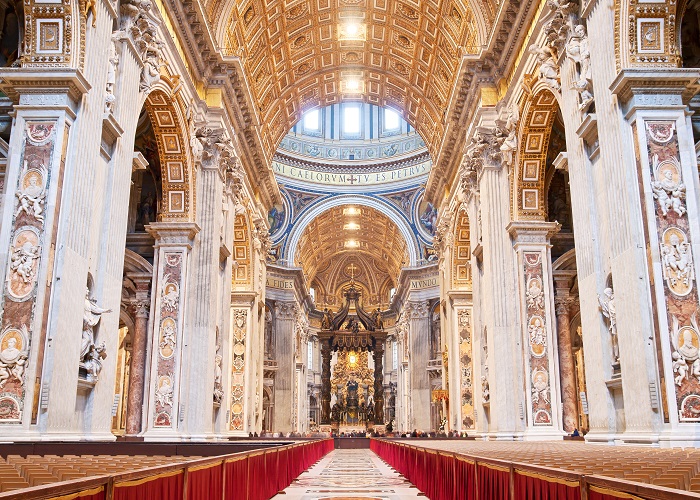
The high altar of St. Peter’s is the main altar of the church where only the pope is allowed to stand and give mass. The baldacchino is a canopy that hovers over the high altar, which has been used since Medieval times. With the advent of the baroque age, things were taken to new heights as we will see.
Once the basilica was finished, it would have appeared that something was still missing in the church. There was no connection between the long nave by Carlo Maderno and the massive dome by Michelangelo. Therefore, pope Urban VIII commissioned Gian Lorenzo Bernini to create a baldacchino to cover the high altar. It was to be made of bronze and, like everything else in the baroque period, would be monumental.
Bernini created a canopy of bronze with spiraling columns going up to the top. Bernini’s inspiration for the columns was taken from columns of a similar style situated in the Basilica of Constantine. The actual height is an astonishing 95 feet (28 meters) high. The material used to make this was taken from the porch roof of the Pantheon. As you approach the center of the church, your eyes naturally gaze up at the baldacchino and continue their trajectory up to the top of the dome.
62. St Peter’s Square
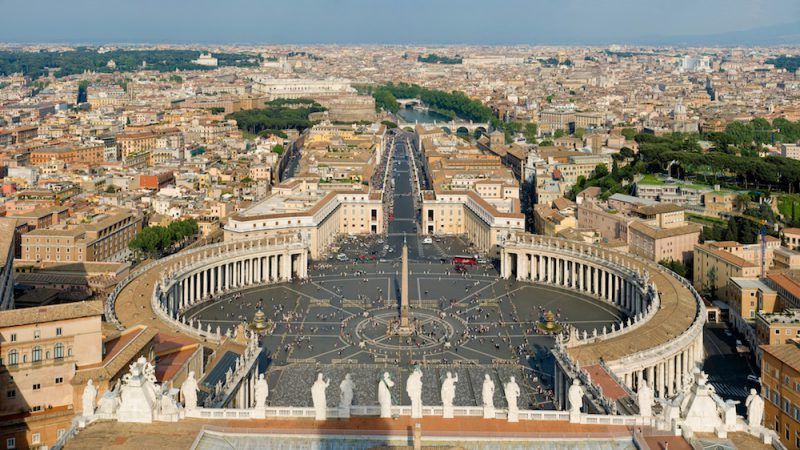
This is the most famous square in the world. The idea of the square was first started by Pope Sixtus V (Pontiff 1585 – 1590) when he ordered the massive Egyptian obelisk moved to the center of the future square (at the time it would have been placed directly in front of the newly finished basilica). The actual works on the square were initiated by Alexander VII (Pontiff 1655 – 1667) and finished in 1667 by the famous architect Bernini.
Design
The square is an elliptical shape and composed of 284 Doric columns four rows deep. The elliptical design was envisioned as a way to embrace all Christians entering St. Peter’s Basilica. Interestingly, if you look at an aerial view of the square, it looks like a keyhole, which goes perfectly with St. Peter since his symbol during Renaissance times and to this day are the two keys (one for Heaven and one for Earth). There are also two gigantic fountains on either side of the square, one created by Carlo Maderno and the other by Bernini himself.
Purpose
Historically, the square would have been a meeting point for the feast of Corpus Christi, which was extremely popular at the time of the square’s construction. Today, the square is mainly used for two events that happen on a weekly basis:
- The Papal Audience—This takes place every Wednesday morning. The pope will bless the crowd and travel around the crowds in the popemobile, blessing everyone as he passes.
- Angelus—This takes place every Sunday at noon. The pope gives a blessing to the crowd below from the historical residence of popes (the current pope doesn’t live there).
Popular Rome Tours
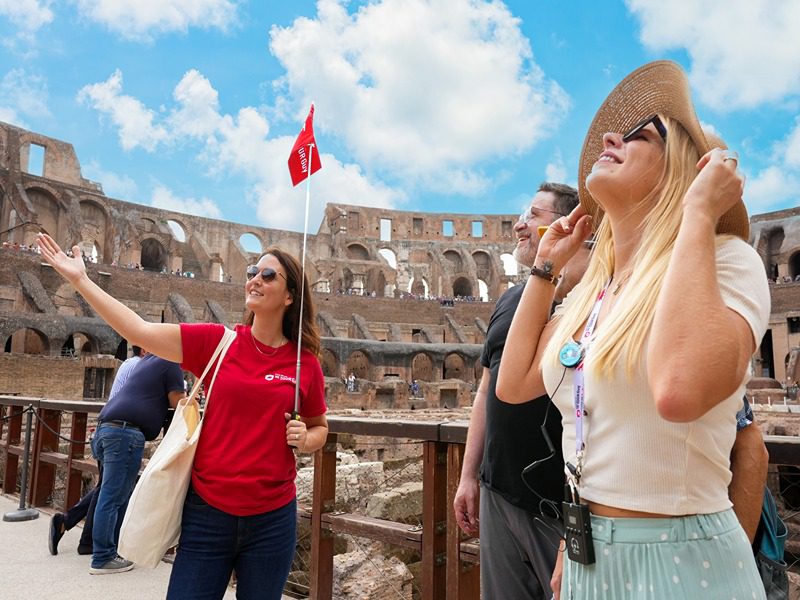
Best-Selling Tour
Rome in a Day Tour with Colosseum and Vatican Museums
Seeing the best of Rome in a single day might seem like a big undertaking, but our expertly designed tour makes it effortless with skip-the-line tickets, included transportation, and engaging guides to lead the way. In just 7 hours, you’ll visit renowned sites like the Sistine Chapel, Colosseum, Trevi Fountain, and Pantheon. With fascinating stories at every stop, you can skip the stress and immerse yourself in the vibrant heritage and culture of Rome all in one remarkable day.
See Prices
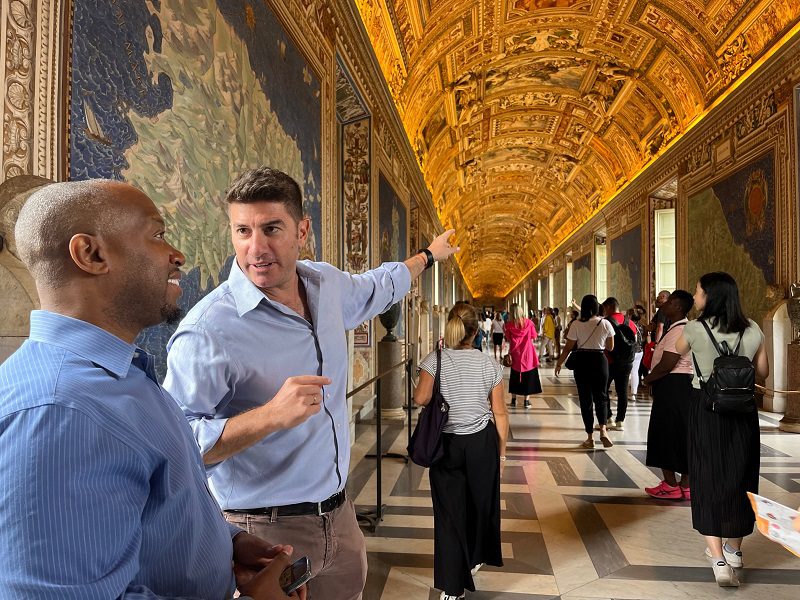
Best Price!
Privileged Entrance Vatican Tour with Sistine Chapel
Without the right access, visiting the Vatican means fighting crowds, long waits, and missing the most significant rooms and works of art. Our privileged entrance tour offers more than just entry—it’s an immersive experience led by a storytelling guide who brings the Vatican to life. Skip the line and explore the Vatican Museums, including the Raphael Rooms and the Sistine Chapel, with engaging insights that make each moment memorable and meaningful.
See Prices
Not ready to book a tour? Check out our best Vatican tours to take and why.
Here’s Where To Stay in Italy’s Most Popular Destinations
Rome, Florence, Venice, Amalfi Coast, and Capri

